Paul van Yperen's Blog, page 17
April 20, 2025
Dorothy Tutin
Dame Dorothy Tutin (1930-2001) was one of the great actresses of the British theatre. Great promise was held for her after her film debut as Cecily Cardew in the Oscar Wilde adaptation The Importance of Being Earnest (1952). Despite acclaimed film roles opposite Laurence Olivier in The Beggar's Opera (1953) and in a remake of A Tale of Two Cities (1958) with Dirk Bogarde, Tutin abruptly left the cinema to return to the stage.
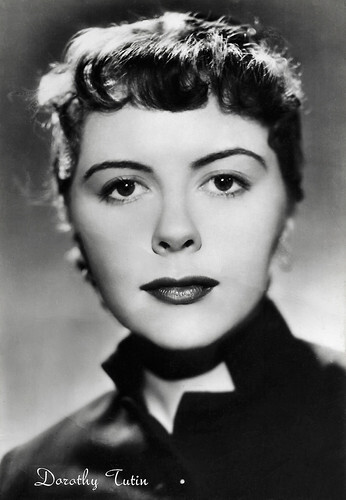
Italian postcard by Rotalfoto, Milano, no. 128. Photo: Rank Film. Dorothy Tutin in The Importance of Being Earnest (Anthony Asquith, 1952).
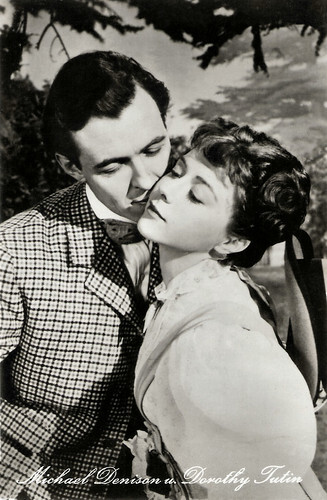
East German postcard by VEB Progress Film-Vertrieb, Berlin, no. 1069, 1959. Photo: J. Arthur Rank. Michael Denison and Dorothy Tutin in The Importance of Being Earnest (Anthony Asquith, 1952).
Ablaze like a diamond in a mine
Dorothy Tutin was born in 1930 in London. She was the daughter of John Tutin and Adie Evelyn Fryers, a Yorkshire couple who married the following year.
Lyn Gardner in her obituary in the Guardian: "A solitary, pent-up child, she was much affected by the sudden death of her beloved 10-year-old elder brother Eric when she was six. Born in London and educated at St Catherine's school in Bramley, Surrey, Tutin was determined to make a career as a musician, but abandoned that ambition at the age of 15, accepting, with a maturity beyond her years, that she did not have the talent."
"It was her theatre-loving father who, impressed by her performance as a last-minute replacement in a school production of J.M. Barrie's 'Quality Street', pushed his self-conscious daughter - who professed a horror at performing in public - towards the stage." Tutin completed her schooling at St Catherine's School near Guildford and went on to study acting at the Royal Academy of Dramatic Art. She graduated at the age of 19 and within a year she was playing Katherine in 'Henry V' at the Old Vic.
Quickly, she became a sought-after stage actress. She made her film debut in 1952 as Cecily in the Oscar Wilde adaptation The Importance of Being Earnest (Anthony Asquith, 1952), for which she received a BAFTA nomination. In the 1950s, she played two other literary characters on the big screen. She was Polly Peachum to Laurence Olivier 's Macheath in The Beggar's Opera (Peter Brook, 1953) based on the play by John Gay. Her next major film role was as Lucie Manette in the Charles Dickens film A Tale of Two Cities (Ralph Thomas, 1958) starring Dirk Bogarde .
However, she turned down other cinema roles as she did not find the main female characters in British cinema of the 1950s interesting enough. On stage, she received great critical acclaim for her performance as a sexually liberated young Catholic in Graham Greene's first play 'The Living Room' in 1953. The critic Kenneth Tynan was entranced, describing her as being "ablaze like a diamond in a mine". In 1954, she played the role of Sally Bowles in the first English production of John Van Druten's play 'I Am a Camera', on which the musical 'Cabaret' is based. After this second memorable performance, she was firmly established.
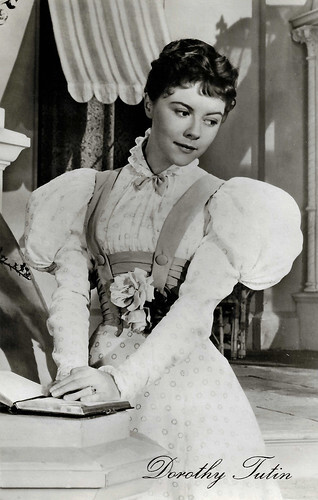
East German postcard by VEB Progress Film-Vertrieb, Berlin, no. 1071, 1959. Photo: J. Arthur Rank. Dorothy Tutin in The Importance of Being Earnest (Anthony Asquith, 1952).
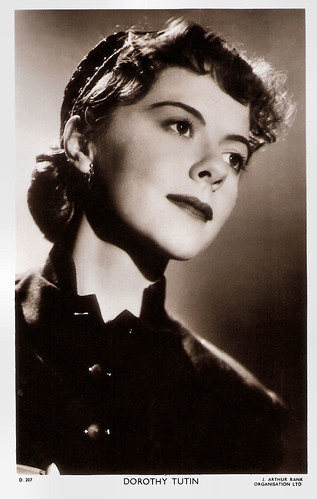
British postcard in the Picturegoer Series, London, no. D 207. Photo: J. Arthur Rank Organisation LTD.
A flop-turned-cult classic
Between 1958 and 1999, Dorothy Tutin performed regularly with the Royal Shakespeare Company, appearing in over two dozen of their productions.
Championed by Peter Hall, Tutin was a key figure in the early days of the RSC at Stratford and London's Aldwych theatre in the early 1960s. She played Desdemona, Varya in 'The Cherry Orchard', Polly Peachum in 'The Beggar's Opera' and, later in the decade, Rosalind.
By the end of her career, she had played almost all of Shakespeare's major female roles, including Juliet, Ophelia, Portia and Lady Macbeth. She was also seen several times in plays by Anton Chekhov, Henrik Ibsen and August Strindberg. She also appeared several times in the works of Harold Pinter, for example in the world premiere of 'Old Times' in 1971.
By the early 1970s, partly preoccupied with marriage and motherhood, Tutin was seen far less in the theatre and more on the big screen again. She played Queen Henrietta in the historical film Cromwell (Ken Hughes, 1970) starring Richard Harris, and in the lead role of the flop-turned-cult classic Savage Messiah (Ken Russell, 1972) in which she played a Polish noblewoman and writer Sophie Brzeska married to the much younger sculptor, Henri Gaudier-Brzeska.
In 1984 she starred with James Mason , Edward Fox and Sir John Gielgud in the critically acclaimed The Shooting Party (Alan Bridges, 1984). The film is set in 1913, less than a year before the beginning of the First World War, and shows a vanishing way of life amongst English aristocrats, focusing on a shooting party gathered for pheasant shooting. Their situation is contrasted with the life of the local rural poor, who work on the estate and during the shoot serve as beaters, driving the game.
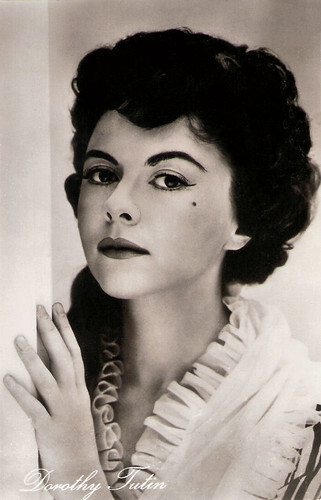
East German postcard by VEB Progress Film-Vertrieb, Berlin, no. 1102, 1959. Photo: J. Arthur Rank.
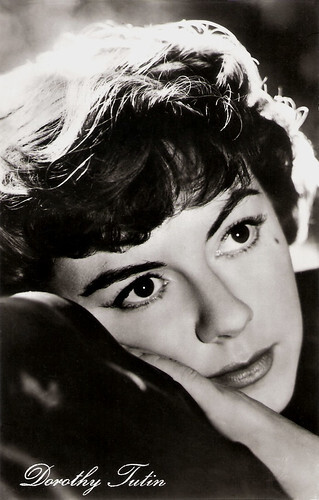
East German postcard by VEB Progress Film-Vertrieb, Berlin, no. 1070, 1959. Photo: J. Arthur Rank. Dorothy Tutin in The Importance of Being Earnest (Anthony Asquith, 1952).
An uncomprehending, terrified middle-aged Sleeping Beauty
From the 1970s to the 1990s, Dorothy Tutin was frequently seen on British television in distinctive character roles in literary adaptations or historical material. She played Anne Boleyn in the BBC's series The Six Wives of Henry VIII (Naomi Capon, John Glenister, 1970), which starred Keith Michell in the title role.
She was nominated three times for a BAFTA Award. In 1970, she was nominated for the BAFTA TV Award for Best Actress for The Six Wives of Henry VIII, in 1973 for Best Actress in a Leading Role for Savage Messiah, and in 1975 for Best Actress for her role as the teacher Sarah Burton in the TV series South Riding (1974), based on the novel 'South Riding' by Winifred Holtby.
Another of her notable roles was as Goneril in an Emmy-winning television production of Shakespeare's King Lear (1983), opposite Laurence Olivier as King Lear. She guest starred in an episode of the 1980s TV series Robin of Sherwood as Lady Margaret of Gisbourne. Both on TV and in the West End, she gave a desperately moving performance, in Harold Pinter's 'A Kind Of Alaska' (1985).
Lyn Gardner in the Guardian: "She played Deborah, a teenager struck down by encephalitis lethargia who awakens 29 years later when given the drug L-DOPA. Tutin was mesmerising as this uncomprehending, terrified middle-aged Sleeping Beauty who still perceived herself as a tomboy teenager, and this should have given a boost to her career. Alas, it didn't. She was pained by her lack of job opportunities, telling the Guardian in 1991: 'You may as well ask, why aren't you employed more, Miss Tutin? One can get depressed'."
For her work in the theatre, Dorothy Tutin won two Olivier Awards and two Evening Standard Awards for Best Actress. She also received a Tony Award nomination for her role in the 1968 original Broadway production of 'Portrait of a Queen'. In 1967, Tutin was made a Commander in the Order of the British Empire for her artistic merits, and in 2000 she was ennobled as a Dame. From 1964 until her death, Tutin was married to the actor Derek Waring. They had a son, Nicholas, and a daughter, Amanda, both of whom were also sometime actors. In 2001, Dorothy Tutin died of leukaemia in King Edward VII Hospital, Midhurst, West Sussex, at the age of 71.
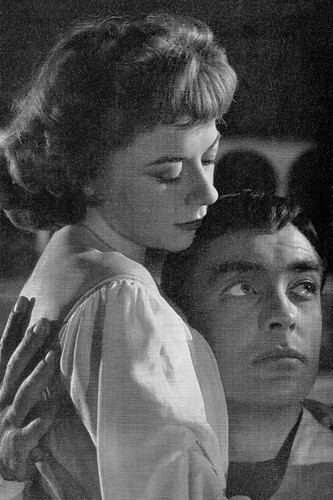
British postcard in the Royal Shakespeare Theatre series, no. 37. Photo: Angus McBean. Caption: Richard Johnson and Dorothy Tutin as Romeo and Juliet, Stratford-upon-Avon 1958.
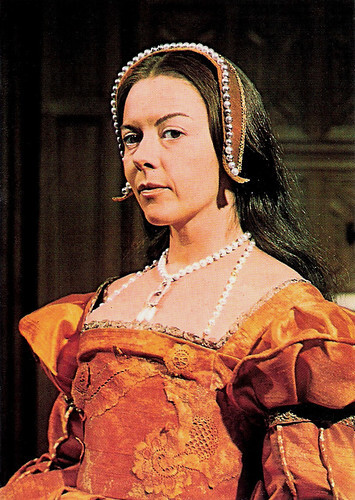
English postcard by British Broadcasting Corporation, 1970, no. SBN 563 10218 7. Dorothy Tutin as Anne Boleyn in the BBC TV series The Six Wives of Henry VIII (Naomi Capon, John Glenister, 1970).
Sources: Lyn Gardner (The Guardian), Wikipedia (German and English) and .

Italian postcard by Rotalfoto, Milano, no. 128. Photo: Rank Film. Dorothy Tutin in The Importance of Being Earnest (Anthony Asquith, 1952).

East German postcard by VEB Progress Film-Vertrieb, Berlin, no. 1069, 1959. Photo: J. Arthur Rank. Michael Denison and Dorothy Tutin in The Importance of Being Earnest (Anthony Asquith, 1952).
Ablaze like a diamond in a mine
Dorothy Tutin was born in 1930 in London. She was the daughter of John Tutin and Adie Evelyn Fryers, a Yorkshire couple who married the following year.
Lyn Gardner in her obituary in the Guardian: "A solitary, pent-up child, she was much affected by the sudden death of her beloved 10-year-old elder brother Eric when she was six. Born in London and educated at St Catherine's school in Bramley, Surrey, Tutin was determined to make a career as a musician, but abandoned that ambition at the age of 15, accepting, with a maturity beyond her years, that she did not have the talent."
"It was her theatre-loving father who, impressed by her performance as a last-minute replacement in a school production of J.M. Barrie's 'Quality Street', pushed his self-conscious daughter - who professed a horror at performing in public - towards the stage." Tutin completed her schooling at St Catherine's School near Guildford and went on to study acting at the Royal Academy of Dramatic Art. She graduated at the age of 19 and within a year she was playing Katherine in 'Henry V' at the Old Vic.
Quickly, she became a sought-after stage actress. She made her film debut in 1952 as Cecily in the Oscar Wilde adaptation The Importance of Being Earnest (Anthony Asquith, 1952), for which she received a BAFTA nomination. In the 1950s, she played two other literary characters on the big screen. She was Polly Peachum to Laurence Olivier 's Macheath in The Beggar's Opera (Peter Brook, 1953) based on the play by John Gay. Her next major film role was as Lucie Manette in the Charles Dickens film A Tale of Two Cities (Ralph Thomas, 1958) starring Dirk Bogarde .
However, she turned down other cinema roles as she did not find the main female characters in British cinema of the 1950s interesting enough. On stage, she received great critical acclaim for her performance as a sexually liberated young Catholic in Graham Greene's first play 'The Living Room' in 1953. The critic Kenneth Tynan was entranced, describing her as being "ablaze like a diamond in a mine". In 1954, she played the role of Sally Bowles in the first English production of John Van Druten's play 'I Am a Camera', on which the musical 'Cabaret' is based. After this second memorable performance, she was firmly established.

East German postcard by VEB Progress Film-Vertrieb, Berlin, no. 1071, 1959. Photo: J. Arthur Rank. Dorothy Tutin in The Importance of Being Earnest (Anthony Asquith, 1952).

British postcard in the Picturegoer Series, London, no. D 207. Photo: J. Arthur Rank Organisation LTD.
A flop-turned-cult classic
Between 1958 and 1999, Dorothy Tutin performed regularly with the Royal Shakespeare Company, appearing in over two dozen of their productions.
Championed by Peter Hall, Tutin was a key figure in the early days of the RSC at Stratford and London's Aldwych theatre in the early 1960s. She played Desdemona, Varya in 'The Cherry Orchard', Polly Peachum in 'The Beggar's Opera' and, later in the decade, Rosalind.
By the end of her career, she had played almost all of Shakespeare's major female roles, including Juliet, Ophelia, Portia and Lady Macbeth. She was also seen several times in plays by Anton Chekhov, Henrik Ibsen and August Strindberg. She also appeared several times in the works of Harold Pinter, for example in the world premiere of 'Old Times' in 1971.
By the early 1970s, partly preoccupied with marriage and motherhood, Tutin was seen far less in the theatre and more on the big screen again. She played Queen Henrietta in the historical film Cromwell (Ken Hughes, 1970) starring Richard Harris, and in the lead role of the flop-turned-cult classic Savage Messiah (Ken Russell, 1972) in which she played a Polish noblewoman and writer Sophie Brzeska married to the much younger sculptor, Henri Gaudier-Brzeska.
In 1984 she starred with James Mason , Edward Fox and Sir John Gielgud in the critically acclaimed The Shooting Party (Alan Bridges, 1984). The film is set in 1913, less than a year before the beginning of the First World War, and shows a vanishing way of life amongst English aristocrats, focusing on a shooting party gathered for pheasant shooting. Their situation is contrasted with the life of the local rural poor, who work on the estate and during the shoot serve as beaters, driving the game.

East German postcard by VEB Progress Film-Vertrieb, Berlin, no. 1102, 1959. Photo: J. Arthur Rank.

East German postcard by VEB Progress Film-Vertrieb, Berlin, no. 1070, 1959. Photo: J. Arthur Rank. Dorothy Tutin in The Importance of Being Earnest (Anthony Asquith, 1952).
An uncomprehending, terrified middle-aged Sleeping Beauty
From the 1970s to the 1990s, Dorothy Tutin was frequently seen on British television in distinctive character roles in literary adaptations or historical material. She played Anne Boleyn in the BBC's series The Six Wives of Henry VIII (Naomi Capon, John Glenister, 1970), which starred Keith Michell in the title role.
She was nominated three times for a BAFTA Award. In 1970, she was nominated for the BAFTA TV Award for Best Actress for The Six Wives of Henry VIII, in 1973 for Best Actress in a Leading Role for Savage Messiah, and in 1975 for Best Actress for her role as the teacher Sarah Burton in the TV series South Riding (1974), based on the novel 'South Riding' by Winifred Holtby.
Another of her notable roles was as Goneril in an Emmy-winning television production of Shakespeare's King Lear (1983), opposite Laurence Olivier as King Lear. She guest starred in an episode of the 1980s TV series Robin of Sherwood as Lady Margaret of Gisbourne. Both on TV and in the West End, she gave a desperately moving performance, in Harold Pinter's 'A Kind Of Alaska' (1985).
Lyn Gardner in the Guardian: "She played Deborah, a teenager struck down by encephalitis lethargia who awakens 29 years later when given the drug L-DOPA. Tutin was mesmerising as this uncomprehending, terrified middle-aged Sleeping Beauty who still perceived herself as a tomboy teenager, and this should have given a boost to her career. Alas, it didn't. She was pained by her lack of job opportunities, telling the Guardian in 1991: 'You may as well ask, why aren't you employed more, Miss Tutin? One can get depressed'."
For her work in the theatre, Dorothy Tutin won two Olivier Awards and two Evening Standard Awards for Best Actress. She also received a Tony Award nomination for her role in the 1968 original Broadway production of 'Portrait of a Queen'. In 1967, Tutin was made a Commander in the Order of the British Empire for her artistic merits, and in 2000 she was ennobled as a Dame. From 1964 until her death, Tutin was married to the actor Derek Waring. They had a son, Nicholas, and a daughter, Amanda, both of whom were also sometime actors. In 2001, Dorothy Tutin died of leukaemia in King Edward VII Hospital, Midhurst, West Sussex, at the age of 71.

British postcard in the Royal Shakespeare Theatre series, no. 37. Photo: Angus McBean. Caption: Richard Johnson and Dorothy Tutin as Romeo and Juliet, Stratford-upon-Avon 1958.

English postcard by British Broadcasting Corporation, 1970, no. SBN 563 10218 7. Dorothy Tutin as Anne Boleyn in the BBC TV series The Six Wives of Henry VIII (Naomi Capon, John Glenister, 1970).
Sources: Lyn Gardner (The Guardian), Wikipedia (German and English) and .
Published on April 20, 2025 22:00
April 19, 2025
La Glu (1913)
French actress and singer Mistinguett (1875-1956) was the most popular French entertainer of her time and captivated Paris with her risqué routines. She also appeared more than 60 times in the cinema such as in the silent S.C.A.G.L. production La Glu / The Siren (Albert Capellani, 1913) with Paul Cappelani and Henry Krauss.
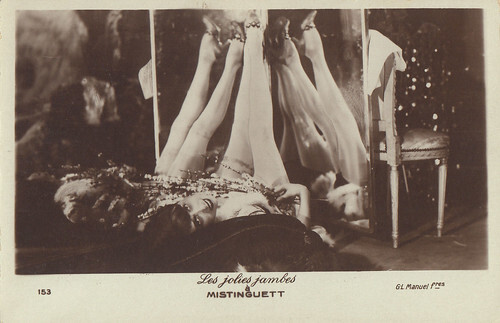
French postcard, no. 153. Photo: G.L. Manuel Frères. Caption: “Les jolies jambes de Mistinguett” (Mistinguett’s pretty legs). Collection: Marlene Pilaete.
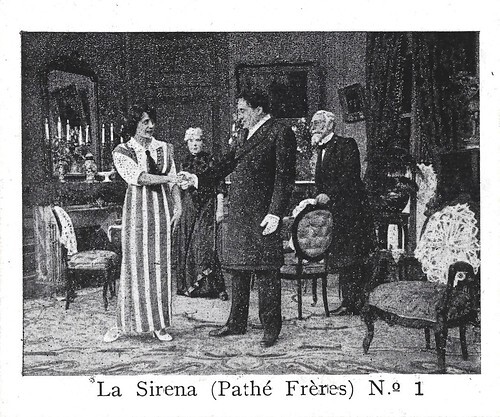
Spanish collector card (minicard) by Reclam Films, no. 1. Photo: S.C.A.G.L. / Pathé Frères. Mistinguett in La Glu / The Siren (Albert Capellani, 1913), presented in Spain as La Sirena. Mistinguett's co-actors were Paul Capellani, Henri Collen, Cécile Guyon, and Henri Krauss (here next to her).
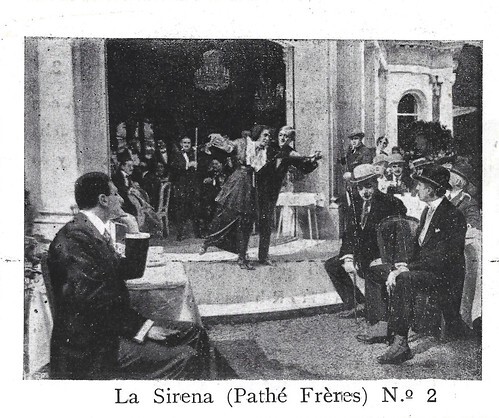
Spanish collector card by Reclam Films, no. 2. Photo: S.C.A.G.L. / Pathé Frères. Mistinguett in La Glu / The Siren (Albert Capellani, 1913).
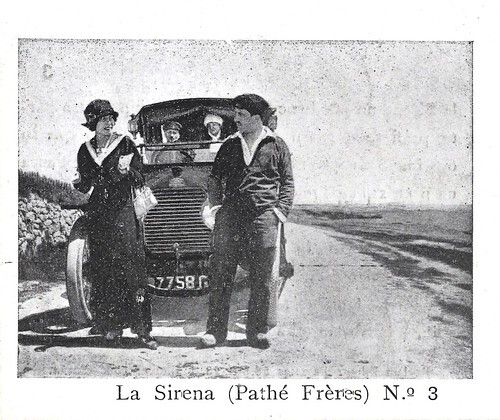
Spanish collector card by Reclam Films, no. 3. Photo: S.C.A.G.L. / Pathé Frères. Mistinguett and Paul Capellani in La Glu / The Siren (Albert Capellani, 1913).
A great flirt
La Glu / The Siren (Albert Capellani, 1913) is based on an 1881 novel and 1883 play of the same name, by the eccentric Romantic writer Jean Richepin. They also served as the model for a 1908 opera by Gabriel Dupont.Mistinguett stars as Fernande, the daughter of poor parents. On IMDb, there is a synopsis by Moving Picture World: "(Fernande) is very much dissatisfied with her lot in life and wants to get out where she can have some pleasure. She is a great flirt and has several men on the string. When the doctor (Henri Krauss) comes to the house she works her wiles on him to such an extent that he asks for her hand in marriage. Fernande accepts him but in her mind has no intention of giving up her other sweethearts. After her marriage, she continues to meet them with the result that he discovers her unfaithfulness. He looks into her private correspondence and finds proof that she has been utterly unfaithful. When he taxes her with it she does not deny it but tells him that she intends to continue the same way. He in a rage strikes her. Driven nearly insane he wanders round all night and on his return finds that she has gone away. He loses all trace of her and goes to a foreign country to try to forget her."
In the meantime, Fernande goes to Paris, where she sets up a little court of her own. Her admirers are many, among them Count Adolphe. He is so much taken with her charms that he decides to marry her. He writes to his grandfather telling him of his decision. Then he goes to Fernande with his proposal. She is rather taken aback as she had not intended to let him get that far in the toils. To avoid his attention she goes to a small town in Brittany where she finds life too slow for her temperament. Being one of that kinds of women who must have an admirer she flirts with a young fisherman. The fisherman, Marie-Pierre (Paul Capellani), is however built of different stuff than the men she has met in Paris and will not be satisfied to merely admire her from a distance. Despite his rough manners, or probably because of them and his immense size, he exerts a charm on Fernande that makes her lose her cool, calculating manner. She allows him to come to her home.
Marie-Pierre's mother has suspected for some time that all is not well with him and follows to learn what is the cause of his desertion of his own wife. Through the good offices of an old friend, she learns that Pierre is spending nearly all of his time at the home of Fernande. Going to the doctor she asks him to do what he can to get Pierre out of the clutches of the woman who is wrecking both their lives. The doctor goes to the villa and on entering finds that not only has Fernande been playing with Pierre, but that she has at the house of Count Adolphe, who has followed her from Paris. He also is astounded to find the woman in the case is Fernande, his own wife who had left his house the night he had struck her. He had no idea that he was located in the same town that she had chosen for her home.
He upbraids her but is met with a penitent air and an exhibition of those same charms that made him love her so long before. He falls victim a second time only to be laughed at and told that he is an old fool. Enraged he tells Pierre and the count who she really is. Pierre, overcome, falls in a faint striking his head and badly hurting himself. He is taken home and orders are given that he is to be kept absolutely quiet if he is to recover. Fernande decides to see him and goes to his home. She is told that it is impossible to see him, but insists. Then Pierre's mother takes a hand and the Siren meets one on whom she cannot work her charms.
Le Journal (7.11.1913), quoted by Henri Bousquet in the Catalogue Pathé 1913: "The old story of the evil femme fatale, an Eve figure causing suffering to decent, tormented men, is neither new nor very pleasant: at the end the mother kills the whore. Oh well. But this film does get under your skin. It can draw an audience – if the audience is willing – under its spell. The exterior shots and, above all, the photographic style are consistently fresh and strikingly beautiful, while the expressive physicality of the star is mesmerising. The passionate love scene with Marie-Pierre, for example, generates a physical empathy hardly ever felt in other films of the time. Mlle Mistinguett plays the role of La Glu with artistry and a profound truthfulness. Messieurs Capellani and Krauss distill from their roles a most moving passion and high dramatic pitch. The production, admirable in every way, in fact nearly turned into a real drama. For we all remember that Mlle Mistinguett, struck by the hammer which was to kill La Glu, fainted, in real life, from the shock; and then we see something that was not in the script: the horrified gesture of Krauss before the bloody figure of his friend at his feet, believing for a moment that she was really dead.”
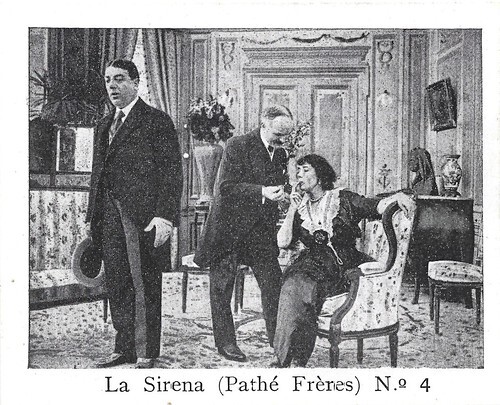
Spanish collector card by Reclam Films, no. 4. Photo: S.C.A.G.L. / Pathé Frères. Mistinguett in La Glu / The Siren (Albert Capellani, 1913) with Henri Collen on the left.
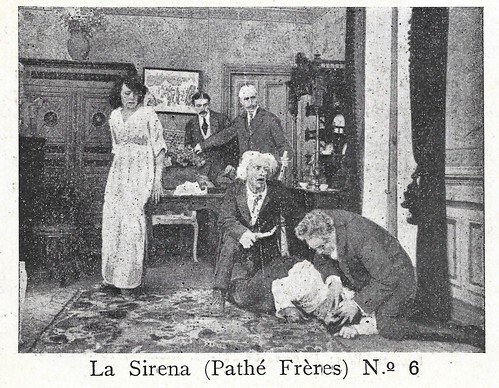
Spanish collector card by Reclam Films, no. 6. Photo: S.C.A.G.L. / Pathé Frères. Mistinguett in La Glu / The Siren (Albert Capellani, 1913). The man lying on the floor is Paul Capellani.
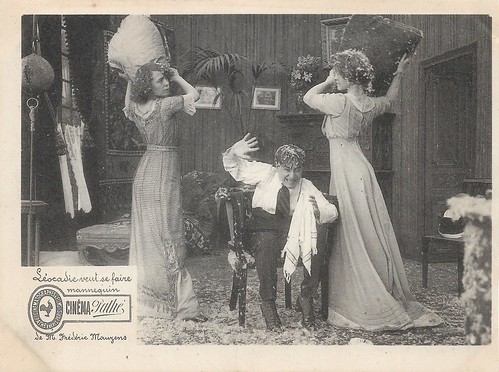
French collector cards by Pathé Frères, 1911. Photo: S.C.A.G.L. / Pathé Frères. Mistinguett and Juliette Clarens in the comedy Léocadie veut se faire mannequin (Pathé Frères, 1911).
Sources: Il Cinema Ritrovato, Wikipedia (French) and IMDb

French postcard, no. 153. Photo: G.L. Manuel Frères. Caption: “Les jolies jambes de Mistinguett” (Mistinguett’s pretty legs). Collection: Marlene Pilaete.

Spanish collector card (minicard) by Reclam Films, no. 1. Photo: S.C.A.G.L. / Pathé Frères. Mistinguett in La Glu / The Siren (Albert Capellani, 1913), presented in Spain as La Sirena. Mistinguett's co-actors were Paul Capellani, Henri Collen, Cécile Guyon, and Henri Krauss (here next to her).

Spanish collector card by Reclam Films, no. 2. Photo: S.C.A.G.L. / Pathé Frères. Mistinguett in La Glu / The Siren (Albert Capellani, 1913).

Spanish collector card by Reclam Films, no. 3. Photo: S.C.A.G.L. / Pathé Frères. Mistinguett and Paul Capellani in La Glu / The Siren (Albert Capellani, 1913).
A great flirt
La Glu / The Siren (Albert Capellani, 1913) is based on an 1881 novel and 1883 play of the same name, by the eccentric Romantic writer Jean Richepin. They also served as the model for a 1908 opera by Gabriel Dupont.Mistinguett stars as Fernande, the daughter of poor parents. On IMDb, there is a synopsis by Moving Picture World: "(Fernande) is very much dissatisfied with her lot in life and wants to get out where she can have some pleasure. She is a great flirt and has several men on the string. When the doctor (Henri Krauss) comes to the house she works her wiles on him to such an extent that he asks for her hand in marriage. Fernande accepts him but in her mind has no intention of giving up her other sweethearts. After her marriage, she continues to meet them with the result that he discovers her unfaithfulness. He looks into her private correspondence and finds proof that she has been utterly unfaithful. When he taxes her with it she does not deny it but tells him that she intends to continue the same way. He in a rage strikes her. Driven nearly insane he wanders round all night and on his return finds that she has gone away. He loses all trace of her and goes to a foreign country to try to forget her."
In the meantime, Fernande goes to Paris, where she sets up a little court of her own. Her admirers are many, among them Count Adolphe. He is so much taken with her charms that he decides to marry her. He writes to his grandfather telling him of his decision. Then he goes to Fernande with his proposal. She is rather taken aback as she had not intended to let him get that far in the toils. To avoid his attention she goes to a small town in Brittany where she finds life too slow for her temperament. Being one of that kinds of women who must have an admirer she flirts with a young fisherman. The fisherman, Marie-Pierre (Paul Capellani), is however built of different stuff than the men she has met in Paris and will not be satisfied to merely admire her from a distance. Despite his rough manners, or probably because of them and his immense size, he exerts a charm on Fernande that makes her lose her cool, calculating manner. She allows him to come to her home.
Marie-Pierre's mother has suspected for some time that all is not well with him and follows to learn what is the cause of his desertion of his own wife. Through the good offices of an old friend, she learns that Pierre is spending nearly all of his time at the home of Fernande. Going to the doctor she asks him to do what he can to get Pierre out of the clutches of the woman who is wrecking both their lives. The doctor goes to the villa and on entering finds that not only has Fernande been playing with Pierre, but that she has at the house of Count Adolphe, who has followed her from Paris. He also is astounded to find the woman in the case is Fernande, his own wife who had left his house the night he had struck her. He had no idea that he was located in the same town that she had chosen for her home.
He upbraids her but is met with a penitent air and an exhibition of those same charms that made him love her so long before. He falls victim a second time only to be laughed at and told that he is an old fool. Enraged he tells Pierre and the count who she really is. Pierre, overcome, falls in a faint striking his head and badly hurting himself. He is taken home and orders are given that he is to be kept absolutely quiet if he is to recover. Fernande decides to see him and goes to his home. She is told that it is impossible to see him, but insists. Then Pierre's mother takes a hand and the Siren meets one on whom she cannot work her charms.
Le Journal (7.11.1913), quoted by Henri Bousquet in the Catalogue Pathé 1913: "The old story of the evil femme fatale, an Eve figure causing suffering to decent, tormented men, is neither new nor very pleasant: at the end the mother kills the whore. Oh well. But this film does get under your skin. It can draw an audience – if the audience is willing – under its spell. The exterior shots and, above all, the photographic style are consistently fresh and strikingly beautiful, while the expressive physicality of the star is mesmerising. The passionate love scene with Marie-Pierre, for example, generates a physical empathy hardly ever felt in other films of the time. Mlle Mistinguett plays the role of La Glu with artistry and a profound truthfulness. Messieurs Capellani and Krauss distill from their roles a most moving passion and high dramatic pitch. The production, admirable in every way, in fact nearly turned into a real drama. For we all remember that Mlle Mistinguett, struck by the hammer which was to kill La Glu, fainted, in real life, from the shock; and then we see something that was not in the script: the horrified gesture of Krauss before the bloody figure of his friend at his feet, believing for a moment that she was really dead.”

Spanish collector card by Reclam Films, no. 4. Photo: S.C.A.G.L. / Pathé Frères. Mistinguett in La Glu / The Siren (Albert Capellani, 1913) with Henri Collen on the left.

Spanish collector card by Reclam Films, no. 6. Photo: S.C.A.G.L. / Pathé Frères. Mistinguett in La Glu / The Siren (Albert Capellani, 1913). The man lying on the floor is Paul Capellani.

French collector cards by Pathé Frères, 1911. Photo: S.C.A.G.L. / Pathé Frères. Mistinguett and Juliette Clarens in the comedy Léocadie veut se faire mannequin (Pathé Frères, 1911).
Sources: Il Cinema Ritrovato, Wikipedia (French) and IMDb
Published on April 19, 2025 22:00
April 18, 2025
Percy Marmont
British actor Percy Marmont (1883-1977) was a tall matinee idol, who divided his time between the theatre and films. He had a prolific career in 1920s Hollywood and 1930s British cinema. He is best remembered as the title character in Lord Jim (1925) and as one of Clara Bow's love interests in Mantrap (1926). He also starred in three British Alfred Hitchcock thrillers. Marmont acted in more than 80 films between 1916 and 1969.
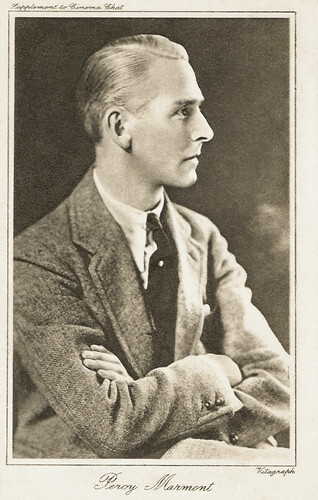
British postcard in the Cinema Chat Series. Photo: Vitagraph.
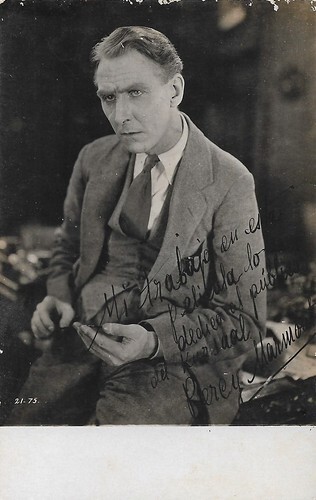
Spanish postcard, no. 21.75. Caption (in Spanish): "I dedicate my work in this film to the audience of the Kursaal". It's not entirely clear but this card could refer to The Street of Forgotten Men (Herbert Brenon, 1925). The Kursaal is the Teatro-Cinema Kursaal in Barcelona, which opened in 1910, went through several changes, closed in 1965 and was demolished, despite being the main and most cherished cinema in Barcelona during its existence. Many cards were issued by this cinema, with Spanish-written dedications supposedly written by the stars (but in reality written by the Kursaal people themselves).
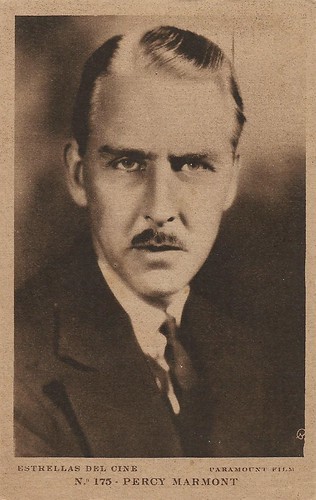
Spanish postcard in the Estrellas del Cine series by Editorial Grafica, Barcelona, no. 175. Photo: Paramount Film.
The first epic in South Africa's motion-picture history
Percy Garfield Marmont was born on the suburban west side of London in 1883. His parents were Cecil Joseph Marmont and Emily Charlotte Wyatt. From 1900 on, he already had some success on London stages and also went on theatrical tours, taking him to South Africa (1913-1916) and Australia (1917).
While touring in South Africa, Marmont appeared as an extra in the film De Voortrekkers / Winning a Continent (Harold M. Shaw, 1916) of which a print was found at the Dutch Eye Filmmuseum a few decades ago. This silent film by African Film Productions was the first epic in South Africa's motion-picture history and also that nation's oldest surviving feature film. It portrays the Boers' 'Great Trek' of the 1830s, concluding with a hegemonic recreation of the Battle of Blood River that occurred on 16 December 1838, when a few hundred armed Afrikaners defeated several thousand Zulus.
In Australia, Marmont made his regular film debut in The Monk and the Woman (Franklyn Barrett, 1917). This now-lost film was controversial and received protests from church groups, being condemned by the Australian Catholic Federation and called "a most offensive travesty on the Catholic religion". However, the film passed the censor and was a major success at the box office.
In the same year, Marmont reached the United States and made his Broadway debut in the comedy 'The Three Bears'. The following year, Marmont went to Los Angeles and continued his film work. He starred opposite Elsie Ferguson in the silent, lost drama Rose of the World (Maurice Tourneur, 1918) produced by Famous Players–Lasky and distributed by Artcraft Pictures, an affiliate of Paramount Pictures.
At Vitagraph, Percy Marmont played the roles of noble heroes and romantic lovers without leaving too much impression. Examples are the comedy-drama The Climbers (Tom Terriss, 1919) opposite Corinne Griffith and the drama Slaves of Pride (George Terwilliger, 1920) starring Alice Joyce . Marmont also starred opposite such leading ladies as Ethel Barrymore and Geraldine Farrar .
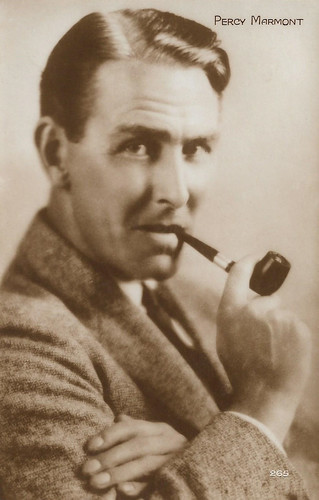
French postcard by Editions Cinémagazine, no. 265.
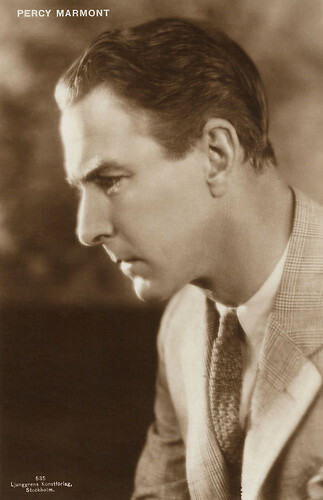
Swedish postcard by Arvid Ljunggrens Konstförlag, Stockholm, no. 535.
A hernia he suffered while picking up Clara Bow
In Hollywood, Percy Marmont had his breakthrough with his part as Mark Sabre in If Winter Comes (Harry Milliarde, 1923) for Fox. Two years after his first major success in the USA, Marmont became the title hero in Paramount's silent film version of Joseph Conrad's Lord Jim (Victor Fleming, 1925), also with Shirley Mason. Another year later he was the film partner of Clara Bow in the comedy Mantrap (Victor Fleming, 1926). On IMDb , I.S. Mowis wrote: "Marmont starred in more than fifty silent films, appearing with some of the top screen actresses of the period, beginning with Corinne Griffith and Alice Joyce at Vitagraph. His perpetually serious, somewhat tortured demeanour may well have been compounded by a hernia he suffered while picking up Clara Bow in Mantrap (1926)."
The often-retold legend that Marmont Lane and the Chateau Marmont in Hollywood refer to Percy Marmont is wrong. In fact, the street predates the hotel by eight years. Marmont Lane was named in 1921 on a tract owned by a dozen investors, none of whom were Percy Marmont. Marmont moved to Hollywood in late 1923, so he could not inspire this street name. 'Marmont' is possibly a portmanteau of mar and monte – Spanish for 'sea' and 'mountain' – alluding to its hilly views of the Pacific, although two of the tract’s owners were Paul and Zida Marlay, for whom nearby Marlay Drive is named, so the 'Mar' might be for them. The Chateau Marmont opened in 1929 as an apartment building.
Back in Britain in 1928, Percy Marmont continued his film career. He played officers, fathers, police inspectors, nobles, cardinals, and other respecters. On stage, he starred in adaptations of classic American plays including 'Witness for the Prosecution' and 'The Philadelphia Story'. Percy Marmont's first full talkie film was probably the mystery thriller The Squeaker (Edgar Wallace, 1930) in which he played the leading part of Captain Leslie.
Making films both in England and Hollywood, he was getting third, fourth and fifth-billing roles, often as a romantic lead. He appeared in three films by Alfred Hitchcock , the romance Rich and Strange (1931) starring Henry Kendall and Joan Barry , the Spy thriller Secret Agent (1936) starring Madeleine Carroll and Peter Lorre , and the crime thriller Young and Innocent (1937) with Nova Pilbeam. In 1936 he shot his only film as a director with the title The Captain's Table (1936). For the small part of Cardinal Wolsey in the French historical comedy Les perles de la couronne / The Pearls of the Crown (Sacha Guitry, 1937), Marmont went to Paris.
In the next decade, Marmont returned to the stage and appeared less and less in films. He rarely played leads, mostly supporting roles. In the 1950s, he appeared in a few television productions. On stage, he partnered with Vivien Leigh in her final British theatrical appearance in 'La Contessa' (1965). In 1968, after a ten-year absence from the camera, the veteran artist returned to the screen with the part of Judge Sir Matthew Gregory in the crime film Hostile Witness (Ray Milland, 1969). Marmont spent the final years of his life, almost blind, at his country estate. Percy Marmont died in London in 1977 at the age of 93. He was married twice, first to Elsie Marguerite Davison and till his death to Dorothy Phyllis Stewart-Dawson, with whom he had two daughters, the actresses Pamela and Patricia Marmont. Actress Emma Vansittart is his granddaughter.
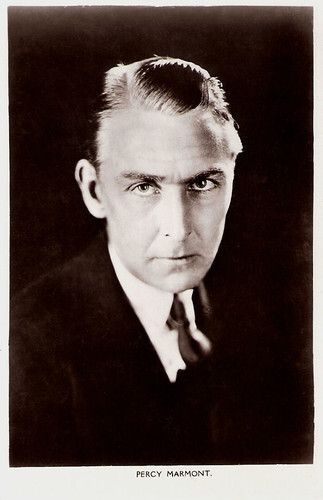
British postcard in the Picturegoer Series, London, no. 46.
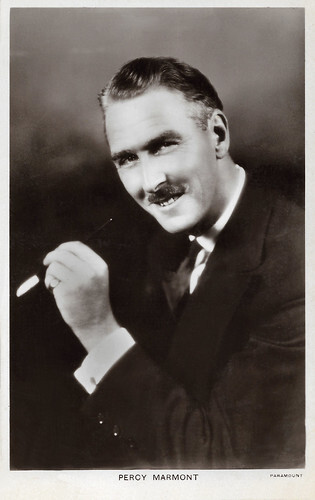
British postcard in the Picturegoer Series, London, no. 46b. Photo: Paramount.
Sources: (IMDb), Graham Thomas (Silent Are Golden), Thomas Staedeli (Cyranos), Daveland, Wikipedia (German and English) and . Thanks to Marlene Pilaete for her additional information and corrections.

British postcard in the Cinema Chat Series. Photo: Vitagraph.

Spanish postcard, no. 21.75. Caption (in Spanish): "I dedicate my work in this film to the audience of the Kursaal". It's not entirely clear but this card could refer to The Street of Forgotten Men (Herbert Brenon, 1925). The Kursaal is the Teatro-Cinema Kursaal in Barcelona, which opened in 1910, went through several changes, closed in 1965 and was demolished, despite being the main and most cherished cinema in Barcelona during its existence. Many cards were issued by this cinema, with Spanish-written dedications supposedly written by the stars (but in reality written by the Kursaal people themselves).

Spanish postcard in the Estrellas del Cine series by Editorial Grafica, Barcelona, no. 175. Photo: Paramount Film.
The first epic in South Africa's motion-picture history
Percy Garfield Marmont was born on the suburban west side of London in 1883. His parents were Cecil Joseph Marmont and Emily Charlotte Wyatt. From 1900 on, he already had some success on London stages and also went on theatrical tours, taking him to South Africa (1913-1916) and Australia (1917).
While touring in South Africa, Marmont appeared as an extra in the film De Voortrekkers / Winning a Continent (Harold M. Shaw, 1916) of which a print was found at the Dutch Eye Filmmuseum a few decades ago. This silent film by African Film Productions was the first epic in South Africa's motion-picture history and also that nation's oldest surviving feature film. It portrays the Boers' 'Great Trek' of the 1830s, concluding with a hegemonic recreation of the Battle of Blood River that occurred on 16 December 1838, when a few hundred armed Afrikaners defeated several thousand Zulus.
In Australia, Marmont made his regular film debut in The Monk and the Woman (Franklyn Barrett, 1917). This now-lost film was controversial and received protests from church groups, being condemned by the Australian Catholic Federation and called "a most offensive travesty on the Catholic religion". However, the film passed the censor and was a major success at the box office.
In the same year, Marmont reached the United States and made his Broadway debut in the comedy 'The Three Bears'. The following year, Marmont went to Los Angeles and continued his film work. He starred opposite Elsie Ferguson in the silent, lost drama Rose of the World (Maurice Tourneur, 1918) produced by Famous Players–Lasky and distributed by Artcraft Pictures, an affiliate of Paramount Pictures.
At Vitagraph, Percy Marmont played the roles of noble heroes and romantic lovers without leaving too much impression. Examples are the comedy-drama The Climbers (Tom Terriss, 1919) opposite Corinne Griffith and the drama Slaves of Pride (George Terwilliger, 1920) starring Alice Joyce . Marmont also starred opposite such leading ladies as Ethel Barrymore and Geraldine Farrar .

French postcard by Editions Cinémagazine, no. 265.

Swedish postcard by Arvid Ljunggrens Konstförlag, Stockholm, no. 535.
A hernia he suffered while picking up Clara Bow
In Hollywood, Percy Marmont had his breakthrough with his part as Mark Sabre in If Winter Comes (Harry Milliarde, 1923) for Fox. Two years after his first major success in the USA, Marmont became the title hero in Paramount's silent film version of Joseph Conrad's Lord Jim (Victor Fleming, 1925), also with Shirley Mason. Another year later he was the film partner of Clara Bow in the comedy Mantrap (Victor Fleming, 1926). On IMDb , I.S. Mowis wrote: "Marmont starred in more than fifty silent films, appearing with some of the top screen actresses of the period, beginning with Corinne Griffith and Alice Joyce at Vitagraph. His perpetually serious, somewhat tortured demeanour may well have been compounded by a hernia he suffered while picking up Clara Bow in Mantrap (1926)."
The often-retold legend that Marmont Lane and the Chateau Marmont in Hollywood refer to Percy Marmont is wrong. In fact, the street predates the hotel by eight years. Marmont Lane was named in 1921 on a tract owned by a dozen investors, none of whom were Percy Marmont. Marmont moved to Hollywood in late 1923, so he could not inspire this street name. 'Marmont' is possibly a portmanteau of mar and monte – Spanish for 'sea' and 'mountain' – alluding to its hilly views of the Pacific, although two of the tract’s owners were Paul and Zida Marlay, for whom nearby Marlay Drive is named, so the 'Mar' might be for them. The Chateau Marmont opened in 1929 as an apartment building.
Back in Britain in 1928, Percy Marmont continued his film career. He played officers, fathers, police inspectors, nobles, cardinals, and other respecters. On stage, he starred in adaptations of classic American plays including 'Witness for the Prosecution' and 'The Philadelphia Story'. Percy Marmont's first full talkie film was probably the mystery thriller The Squeaker (Edgar Wallace, 1930) in which he played the leading part of Captain Leslie.
Making films both in England and Hollywood, he was getting third, fourth and fifth-billing roles, often as a romantic lead. He appeared in three films by Alfred Hitchcock , the romance Rich and Strange (1931) starring Henry Kendall and Joan Barry , the Spy thriller Secret Agent (1936) starring Madeleine Carroll and Peter Lorre , and the crime thriller Young and Innocent (1937) with Nova Pilbeam. In 1936 he shot his only film as a director with the title The Captain's Table (1936). For the small part of Cardinal Wolsey in the French historical comedy Les perles de la couronne / The Pearls of the Crown (Sacha Guitry, 1937), Marmont went to Paris.
In the next decade, Marmont returned to the stage and appeared less and less in films. He rarely played leads, mostly supporting roles. In the 1950s, he appeared in a few television productions. On stage, he partnered with Vivien Leigh in her final British theatrical appearance in 'La Contessa' (1965). In 1968, after a ten-year absence from the camera, the veteran artist returned to the screen with the part of Judge Sir Matthew Gregory in the crime film Hostile Witness (Ray Milland, 1969). Marmont spent the final years of his life, almost blind, at his country estate. Percy Marmont died in London in 1977 at the age of 93. He was married twice, first to Elsie Marguerite Davison and till his death to Dorothy Phyllis Stewart-Dawson, with whom he had two daughters, the actresses Pamela and Patricia Marmont. Actress Emma Vansittart is his granddaughter.

British postcard in the Picturegoer Series, London, no. 46.

British postcard in the Picturegoer Series, London, no. 46b. Photo: Paramount.
Sources: (IMDb), Graham Thomas (Silent Are Golden), Thomas Staedeli (Cyranos), Daveland, Wikipedia (German and English) and . Thanks to Marlene Pilaete for her additional information and corrections.
Published on April 18, 2025 22:00
April 17, 2025
Friedrich Kayssler
Friedrich Kayssler (1874-1945) was a German theatre and film actor, writer and composer. He appeared in 56 films between 1913 and 1945.
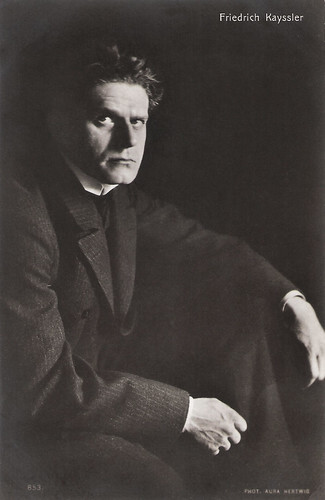
German postcard, no. 853. Photo: Aura Hertwig.
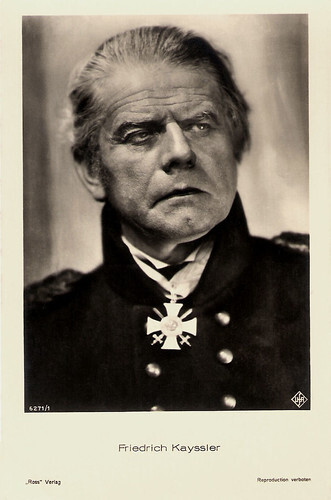
German postcard by Ross Verlag, no. 6271/1, 1931-1932. Photo: Ufa.
Friends with director Max Reinhardt
Friedrich Martin Adalbert Kayssler was born in Neurode in the Prussian Silesia Province, now Nowa Ruda in Poland in 1874. He attended the gymnasium in Breslau (Wrocław), where he became a close friend of Christian Morgenstern and Fritz Beblo. Kayßler studied philosophy at the universities of Breslau and Munich and graduated in 1893.
He began his theatre career at the Deutsches Theater in Berlin under manager Otto Brahm. Later, he worked at municipal theatres in Görlitz and Halle. When he resided in Görlitz he met his first wife Luise, who was an actress at the theatre in that place. At the Deutsches Theater, Kayßler made friends with director Max Reinhardt . Together they started the cabaret 'Schall und Rauch' in 1901. Christian Morgenstern joined them as a regular author. In 1904 he met Helene Fehdmer, who played Lola Montez at the Neues Theater. In 1905, she became his second wife and remained so till she died in 1939.
Kayssler followed Reinhardt, when he became the manager of the Deutsches Theater in 1905, where Kayßler performed in Heinrich von Kleist's 'The Prince of Homburg', Goethe's 'Faust' and Henrik Ibsen's 'Peer Gynt'. He succeeded Reinhardt as manager of the Berlin Volksbühne from 1918 until 1923. During this time, he discovered director Ludwig Berger and signed on Veit Harlan , Heinz Hilpert and Lucie Mannheim. Kayssler wrote several poems and dramas. In 1934 he starred alongside Veit Harlan in the Berlin premiere of Eugen Ortner's 'Meier Helmbrecht' at the Staatliches Schauspielhaus.
In 1913 Friedrich Kayssler made his film debut in the silent film Welche sterben, wenn sie lieben / Which Die When They Love (Carl Schönfeld, 1913). As the ambitious tunnel-building engineer Max Allan, he was the star of Der Tunnel / The Tunnel (William Wauer, 1915), based on Bernhard Kellermann's classic novel about the construction of a vast tunnel under the Atlantic Ocean connecting Europe and America.
Opposite Henny Porten he acted in various films in the 1920s: Die Liebe einer Königin / The Love of a Queen (Ludwig Wolff, 1923), Mutter und Kind / Mother and Child (Carl Froelich, 1924), Gräfin Donelli / Countess Donelli (G.W. Pabst, 1924), and later on, Luise, Königin von Preußen / Louise, Queen of Prussia (Carl Froehlich, 1931) and 24 Stunden aus dem Leben einer Frau / 24 Hours in the Life of a Woman (Robert Land, 1931). He also acted with Maria Corda in Tragödie im Hause Habsburg / Tragedy in the House of Habsburg (Alexander Korda, 1924) and Eine Dubarry von heute / A Modern Dubarry (Alexander Korda, 1927) and with Mady Christians in Das brennende Herz / The Burning Heart (Ludwig Berger, 1929).
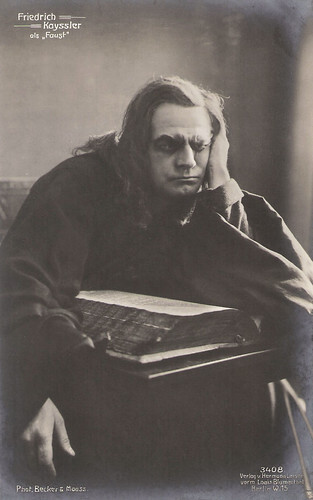
German postcard by Verlag Hermann Leiser, Berlin-Wilm., formerly Louis Blumenthal, no. 3408. Photo: Becker & Maass, Caption: Friedrich Kayssler as Faust.
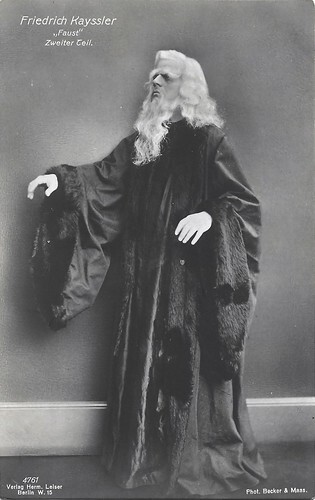
German postcard by Verlag Hermann Leiser, no. 4761. Photo: Becker & Maass. Friedrich Kayssler in Goethe's play 'Faust, Part II'.
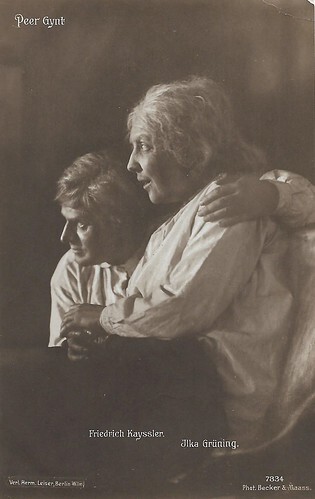
German postcard by Verlag Hermann Leiser, Berlin, no. 7834. Photo: Becker & Maass. Friedrich Kayssler as Peer Gynt and Ilka Grüning as his mother Aase in Ibsen's play 'Peer Gynt'. Kayssler debuted as Peer Gynt at the Lessingtheater in Berlin, on 15 September 1913. Grüning already then played his mother Aase. With the Lessing Theater company, Kayssler and Grüning would perform the play in Spring 1914 at the Neues Deutsches Theater in Prague, the Theater an der Wien in Vienna, and the Lobe-Theater at Breslau/Wroclaw.
Murdered by Red Army troops when trying to protect his wife
Between 1930 and the early 1940s, Friedrich Kayssler was also extremely active in German sound cinema. He acted in such films as the anti-war film Zwei Welten (Ewald André Dupont, 1930), the German version of Dupont's British sound film Two Worlds (Ewald André Dupont, 1930), Stürme über dem Mont Blanc / Storm Over Mont Blanc (Arnold Fanck, 1931) with Leni Riefenstahl , Das Flötenkonzert von Sans-Souci / The Flute Concert of Sanssouci (Gustav Ucicky, 1930) with Otto Gebühr , the Harry Piel thriller Das Schiff ohne Hafen / Ship Without a Harbour (Harry Piel, 1931), and the comedy Der Hauptmann von Köpenick / The Captain from Köpenick (Richard Oswald, 1931) with Max Adalbert.
In 1932 he played the lead in the period piece on the Napoleonic wars, Die elf Schill'schen Offiziere / The Eleven Schill Officers (Rudolf Meinert, 1932). Other remarkable parts Kayssler had in the German Science Fiction film Gold (Karl Hartl, 1934) with Hans Albers , and the historical drama Der alte und der junge König / The Old and the Young King (Hans Steinhoff, 1935) with Emil Jannings . Part of the tradition of Prussian films of the Weimar and Nazi eras, the film ostensibly deals with the intense conflict between Prussian King Friedrich Wilhelm I and his son and heir, Crown Prince Friedrich – the future King Friedrich II 'The Great'.
From 1933 onwards he worked for the Staatstheater, where he was directed by Gustaf Gründgens and Jürgen Fehling. Under the Nazi regime, Kayssler had the lead in the anti-Russian film Friesennot / Frisians in Peril (Willi Krause aka Peter Hagen, 1935) about a village of ethnic Frisians in Russia. Other important leads he had in the Sherlock Holmes film Der Hund von Baskerville / The Hound of the Baskervilles (Carl Lamac, 1937), the Heinrich von Kleist adaptation Der zerbrochene Krug / The Broken Jug (Gustav Ucicky, 1937) with Emil Jannings , and as police prefect of Paris in the historical drama Verwehte Spuren / Covered Tracks (Veit Harlan, 1938).
During the war years, he played King of Prussia Wilhelm I (German Emperor William I) in Bismarck (Wolfgang Liebeneiner, 1940) opposite Paul Hartmann as the title figure, and finally, he was Clara Schumann's father in Träumerei / Reverie (Harald Braun, 1944) with Hilde Krahl as Clara and Mathias Wieman as Robert Schuman.
In March 1944, his son Christian Kayssler, who was also a popular film actor, was killed in an Allied bombing raid. Friedrich Kayßler was named one of the Third Reich's most important artists in the Gottbegnadeten list of September 1944. On 30 April 1945, during the Battle of Berlin, he was trying to protect his landlady and was shot by Russian marauders at his door at the Max-Reimann-Strasse 17 in the suburb of Kleinmachnow near Berlin

German postcard by Ross Verlag, no. 695/4. Photo: Maxim Film. Henny Porten , Ferdinand von Alten , and Friedrich Kayssler in Gräfin Donelli (G.W. Pabst, 1924).
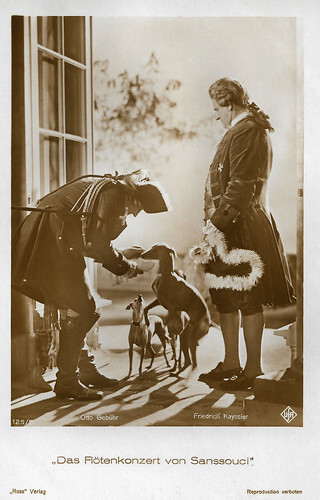
German postcard by Ross Verlag, no. 125/7. Photo: Ufa. Otto Gebühr as King Frederick the Great (Friedrich II) of Prussia and Friedrich Kayssler as Count Karl-Wilhelm Finck von Finckenstein in the early sound film Das Flötenkonzert von Sanssouci (Gustav von Ucicky, 1930). It was part of the popular cycle of Prussian films.
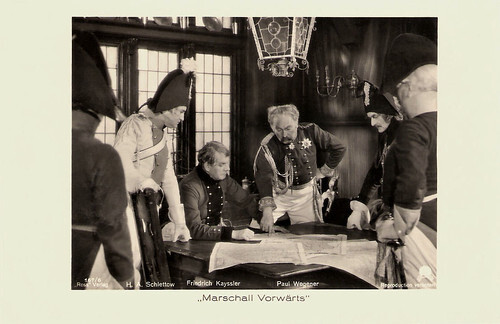
German postcard by Ross Verlag, no. 167/6. Photo: Hans Adalbert Schlettow , Friedrich Kayssler and Paul Wegener in Marschall Vorwärts / Marshal Forwards (Heinz Paul, 1932).
Source: Androom, Wikipedia (German and English) and .

German postcard, no. 853. Photo: Aura Hertwig.

German postcard by Ross Verlag, no. 6271/1, 1931-1932. Photo: Ufa.
Friends with director Max Reinhardt
Friedrich Martin Adalbert Kayssler was born in Neurode in the Prussian Silesia Province, now Nowa Ruda in Poland in 1874. He attended the gymnasium in Breslau (Wrocław), where he became a close friend of Christian Morgenstern and Fritz Beblo. Kayßler studied philosophy at the universities of Breslau and Munich and graduated in 1893.
He began his theatre career at the Deutsches Theater in Berlin under manager Otto Brahm. Later, he worked at municipal theatres in Görlitz and Halle. When he resided in Görlitz he met his first wife Luise, who was an actress at the theatre in that place. At the Deutsches Theater, Kayßler made friends with director Max Reinhardt . Together they started the cabaret 'Schall und Rauch' in 1901. Christian Morgenstern joined them as a regular author. In 1904 he met Helene Fehdmer, who played Lola Montez at the Neues Theater. In 1905, she became his second wife and remained so till she died in 1939.
Kayssler followed Reinhardt, when he became the manager of the Deutsches Theater in 1905, where Kayßler performed in Heinrich von Kleist's 'The Prince of Homburg', Goethe's 'Faust' and Henrik Ibsen's 'Peer Gynt'. He succeeded Reinhardt as manager of the Berlin Volksbühne from 1918 until 1923. During this time, he discovered director Ludwig Berger and signed on Veit Harlan , Heinz Hilpert and Lucie Mannheim. Kayssler wrote several poems and dramas. In 1934 he starred alongside Veit Harlan in the Berlin premiere of Eugen Ortner's 'Meier Helmbrecht' at the Staatliches Schauspielhaus.
In 1913 Friedrich Kayssler made his film debut in the silent film Welche sterben, wenn sie lieben / Which Die When They Love (Carl Schönfeld, 1913). As the ambitious tunnel-building engineer Max Allan, he was the star of Der Tunnel / The Tunnel (William Wauer, 1915), based on Bernhard Kellermann's classic novel about the construction of a vast tunnel under the Atlantic Ocean connecting Europe and America.
Opposite Henny Porten he acted in various films in the 1920s: Die Liebe einer Königin / The Love of a Queen (Ludwig Wolff, 1923), Mutter und Kind / Mother and Child (Carl Froelich, 1924), Gräfin Donelli / Countess Donelli (G.W. Pabst, 1924), and later on, Luise, Königin von Preußen / Louise, Queen of Prussia (Carl Froehlich, 1931) and 24 Stunden aus dem Leben einer Frau / 24 Hours in the Life of a Woman (Robert Land, 1931). He also acted with Maria Corda in Tragödie im Hause Habsburg / Tragedy in the House of Habsburg (Alexander Korda, 1924) and Eine Dubarry von heute / A Modern Dubarry (Alexander Korda, 1927) and with Mady Christians in Das brennende Herz / The Burning Heart (Ludwig Berger, 1929).

German postcard by Verlag Hermann Leiser, Berlin-Wilm., formerly Louis Blumenthal, no. 3408. Photo: Becker & Maass, Caption: Friedrich Kayssler as Faust.

German postcard by Verlag Hermann Leiser, no. 4761. Photo: Becker & Maass. Friedrich Kayssler in Goethe's play 'Faust, Part II'.

German postcard by Verlag Hermann Leiser, Berlin, no. 7834. Photo: Becker & Maass. Friedrich Kayssler as Peer Gynt and Ilka Grüning as his mother Aase in Ibsen's play 'Peer Gynt'. Kayssler debuted as Peer Gynt at the Lessingtheater in Berlin, on 15 September 1913. Grüning already then played his mother Aase. With the Lessing Theater company, Kayssler and Grüning would perform the play in Spring 1914 at the Neues Deutsches Theater in Prague, the Theater an der Wien in Vienna, and the Lobe-Theater at Breslau/Wroclaw.
Murdered by Red Army troops when trying to protect his wife
Between 1930 and the early 1940s, Friedrich Kayssler was also extremely active in German sound cinema. He acted in such films as the anti-war film Zwei Welten (Ewald André Dupont, 1930), the German version of Dupont's British sound film Two Worlds (Ewald André Dupont, 1930), Stürme über dem Mont Blanc / Storm Over Mont Blanc (Arnold Fanck, 1931) with Leni Riefenstahl , Das Flötenkonzert von Sans-Souci / The Flute Concert of Sanssouci (Gustav Ucicky, 1930) with Otto Gebühr , the Harry Piel thriller Das Schiff ohne Hafen / Ship Without a Harbour (Harry Piel, 1931), and the comedy Der Hauptmann von Köpenick / The Captain from Köpenick (Richard Oswald, 1931) with Max Adalbert.
In 1932 he played the lead in the period piece on the Napoleonic wars, Die elf Schill'schen Offiziere / The Eleven Schill Officers (Rudolf Meinert, 1932). Other remarkable parts Kayssler had in the German Science Fiction film Gold (Karl Hartl, 1934) with Hans Albers , and the historical drama Der alte und der junge König / The Old and the Young King (Hans Steinhoff, 1935) with Emil Jannings . Part of the tradition of Prussian films of the Weimar and Nazi eras, the film ostensibly deals with the intense conflict between Prussian King Friedrich Wilhelm I and his son and heir, Crown Prince Friedrich – the future King Friedrich II 'The Great'.
From 1933 onwards he worked for the Staatstheater, where he was directed by Gustaf Gründgens and Jürgen Fehling. Under the Nazi regime, Kayssler had the lead in the anti-Russian film Friesennot / Frisians in Peril (Willi Krause aka Peter Hagen, 1935) about a village of ethnic Frisians in Russia. Other important leads he had in the Sherlock Holmes film Der Hund von Baskerville / The Hound of the Baskervilles (Carl Lamac, 1937), the Heinrich von Kleist adaptation Der zerbrochene Krug / The Broken Jug (Gustav Ucicky, 1937) with Emil Jannings , and as police prefect of Paris in the historical drama Verwehte Spuren / Covered Tracks (Veit Harlan, 1938).
During the war years, he played King of Prussia Wilhelm I (German Emperor William I) in Bismarck (Wolfgang Liebeneiner, 1940) opposite Paul Hartmann as the title figure, and finally, he was Clara Schumann's father in Träumerei / Reverie (Harald Braun, 1944) with Hilde Krahl as Clara and Mathias Wieman as Robert Schuman.
In March 1944, his son Christian Kayssler, who was also a popular film actor, was killed in an Allied bombing raid. Friedrich Kayßler was named one of the Third Reich's most important artists in the Gottbegnadeten list of September 1944. On 30 April 1945, during the Battle of Berlin, he was trying to protect his landlady and was shot by Russian marauders at his door at the Max-Reimann-Strasse 17 in the suburb of Kleinmachnow near Berlin

German postcard by Ross Verlag, no. 695/4. Photo: Maxim Film. Henny Porten , Ferdinand von Alten , and Friedrich Kayssler in Gräfin Donelli (G.W. Pabst, 1924).

German postcard by Ross Verlag, no. 125/7. Photo: Ufa. Otto Gebühr as King Frederick the Great (Friedrich II) of Prussia and Friedrich Kayssler as Count Karl-Wilhelm Finck von Finckenstein in the early sound film Das Flötenkonzert von Sanssouci (Gustav von Ucicky, 1930). It was part of the popular cycle of Prussian films.

German postcard by Ross Verlag, no. 167/6. Photo: Hans Adalbert Schlettow , Friedrich Kayssler and Paul Wegener in Marschall Vorwärts / Marshal Forwards (Heinz Paul, 1932).
Source: Androom, Wikipedia (German and English) and .
Published on April 17, 2025 22:00
April 16, 2025
Cesar Romero
Tall, suave and sophisticated Cesar Romero (1907-1994) was an American actor, singer, dancer, voice artist, and comedian who was active in film, radio, and television for almost 60 years. His screen roles included Latin lovers, historical figures in costume dramas, characters in light domestic comedies, and The Joker in the camp 1960s Batman television series. He was the first actor to play the white-faced, green-haired, cackling villain.
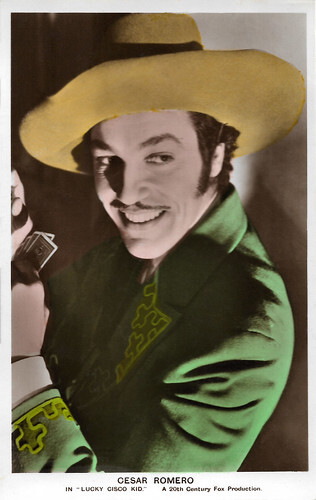
British postcard in the Colourgraph Series, London, no. C 374. Photo: 20th Century Fox. Cesar Romero in Lucky Cisco Kid (H. Bruce Humberstone, 1940).
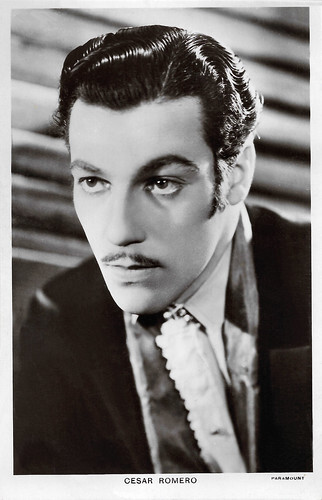
British postcard in the Picturegoer Series, London, no. 1040. Photo: Paramount.
Ballroom dancer
César Julio Romero Jr. was born in New York City in 1907. His parents were César Julio Romero, a Spanish import-export merchant in the sugar business, and Cuban concert singer Maria Mantilla. His grandfather was the Cuban poet and revolutionary hero José Martí. César attended the Collegiate School and Riverdale Country School.
His father got him a job in a bank on Wall Street. At the same time, Romero made his debut as a ballroom dancer in 1927. His father lost almost his entire fortune in the stock market crash of 1929 on Black Thursday. From then on, Cesar had to use his income as an actor to help finance his two sisters, parents, niece and nephew.
He first appeared on Broadway in the 1927 production of 'Lady Do', and then in the stage production of 'Strictly Dishonorable'. In 1932, he made his debut as an actor on Broadway. Romero signed a three-year contract with Universal Studios in the early 1930s. He made his film debut as Tony Rico in the mystery film The Shadow Laughs (Arthur Hoerl, 1933).
He went on to star in films such as The Thin Man (W.S. Van Duke, 1934) with William Powell and Myrna Loy , and The Devil is a Woman (Josef von Sternberg, 1935) opposite Marlene Dietrich . Romero sometimes played the leading man, for example in Allan Dwan's 15 Maiden Lane (1936) opposite Claire Trevor.
He was then poached by Darryl F. Zanuck for 20th Century Fox, where he starred in John Ford's British Raj-era action film Wee Willie Winkie (1937) also starring Shirley Temple and Victor McLaglen and played a supporting role as the Indian servant Ram Dass in The Little Princess (Walter Lang, 1939), also with Temple. He played the key role of the Doc Holliday character in the acclaimed Wyatt Earp saga Frontier Marshal (Allan Dwan, 1939) starring Randolph Scott .
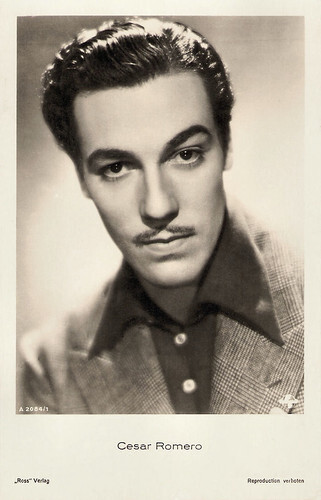
German postcard by Ross Verlag, no. A 2084/1, 1939-1940.
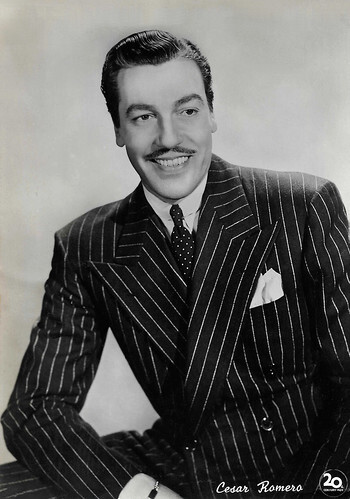
Italian postcard by Ediz. Garami / Rotalfoto, Milano, no. 116. Photo: 20th Century Fox.
The Joker
Between 1939 and 1942, Cesar Romero played a leading role in a string of low-budget Westerns about the rough bandit The Cisco Kid. He stayed with Fox for 15 years and did three years of military service with the United States Coast Guard during World War II.
Romero danced and acted opposite Carmen Miranda and Betty Grable in the Technicolor musicals Week-End in Havana (Walter Lang, 1941) and Springtime in the Rockies (Irving Cummings, 1942). Romero co-starred with Tyrone Power in the historical epic Captain from Castile (Henry King, 1947). While Power played a fictionalised character, Romero played Hernán Cortés, a historical conquistador in Spain's conquest of the Americas.
After the studio system collapsed in the late 1940s and early 1950s, he lost his contract with Fox. Romero went on to appear in almost countless television series. As Steve McQuinn, he acted in 28 episodes of the espionage TV serial Passport to Danger (1954-1958). It earned him a considerable income due to a canny profit-sharing arrangement.
He also appeared in a comic turn as a foil for Frank Sinatra and his crew in Ocean's 11 (Lewis Milestone, 1960) starring the Rat Pack (Sinatra, Dean Martin , Sammy Davis Jr., Peter Lawford and Joey Bishop). In 1963, he was nominated for a Golden Globe for his supporting role as Robert Swan in the film comedy If a Man Answers (Henry Levin, 1962) starring Bobby Darin and Sandra Dee .
Romero achieved international fame through his portrayal of the Joker in the television series Batman (1966-1968). He appeared in 22 episodes, and in the film version, Batman: The Movie (Leslie H. Martinson, 1966). He refused to shave his moustache for the role, so the supervillain's white face makeup was simply smeared over it.
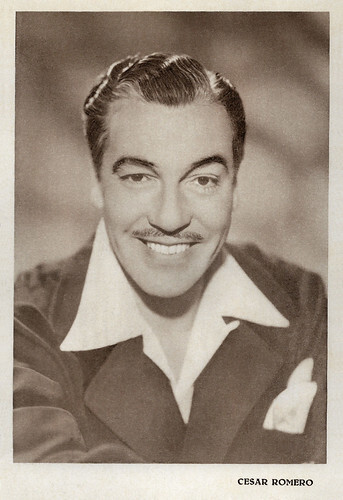
Vintage postcard.
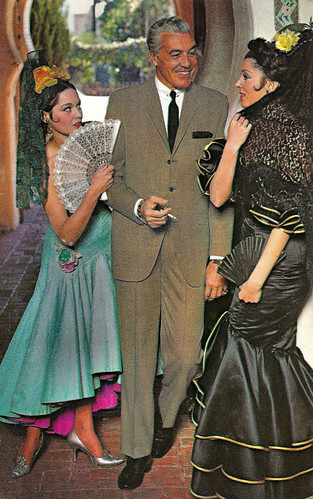
Spanish promotion postcard by Petrocelli. Photo: Tom Kelley. Caption: Madrid, Television and film artist Cesar Romerto in his suit by Petrocelli is the centre of attention. Curiously the postcard was sent from Spain by entertainer Jack Elam. He wrote: Dear Friend: Having a most interesting time in Madrid attending the Petrocelli International Men's Fashion Show & Fietsa. Spain is fabulous and stimulating and so are the Suits and Sport Coats being shown - the best of which you can now see and try on before our mirror. Ole - for your good appearance. My best regards. Cordially, Jack Elam.
Staunchly single
In the 1970s and 1980s, Cesar Romero toured the country with stage productions. He also played the bumbling corporate villain A. J. Arno in the fun-packed Disney films The Computer Wore Tennis Shoes (Robert Butler, 1969), Now You See Him, Now You Don't (Robert Butler, 1972) and The Strongest Man in the World (Vincent McEveety, 1975) alongside Kurt Russell.
His guest star work in the 1970s included a recurring role in the Western comedy Alias Smith and Jones. He increasingly appeared in individual episodes of television series such as Fantasy Island (1977) and Murder, She Wrote (1984). His last major role was that of Peter Stavros, the husband of matriarch Angela Gioberti Channing, played by leading lady Jane Wyman, in the television series Falcon Crest (1985-1988). He portrayed Stavros in 51 episodes.
In the cinema, he played Father Garcia in the Western comedy Lust in the Dust (Paul Bartel, 1985) starring Tab Hunter and Divine, and he appeared in the Horror film Judgement Day (Ferde Grofé Jr., 1988).
He also appeared in an episode of The Golden Girls (1990), as a suitor for Sophia named Tony Delvecchio. Although Romero stopped acting in 1990, he remained busy, regularly hosting classic movie programs on cable television.
On 1 January 1994, Cesar Romero died from complications of a blood clot while being treated for bronchitis and pneumonia at Saint John's Health Center in Santa Monica, California. He was 86. His body was cremated and the ashes were interred at Inglewood Park Cemetery, Inglewood, California. The unmarried Romero was described as ‘staunchly single’, a euphemism for his homosexuality which was not made public during his lifetime.
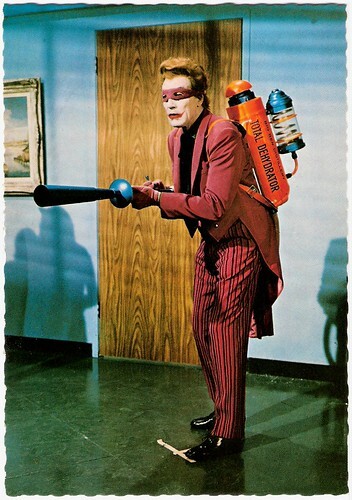
Dutch postcard by Vita Nova, Schiedam, no. 10 B/10/49. Photo: National Periodical Publications Inc. / 20th Century-Fox Film. Cesar Romero as the Joker in Batman: The Movie (Leslie Martinson, 1966).
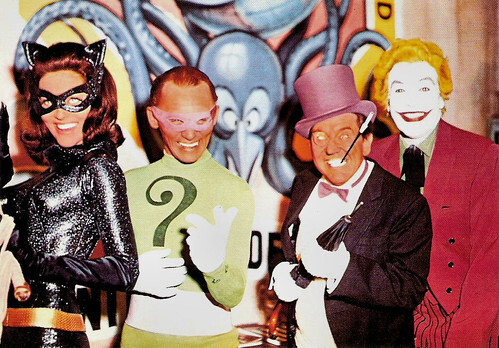
Dutch promotional postcard for Okee. Photo: National Periodical Publications Inc. / 20th Century Fox. Publicity still for Batman: The Movie (Leslie Martinson, 1966) with Lee Meriwether as The Catwoman / Kitka, Frank Gorshin as The Riddler, Burgess Meredith as The Penguin, and Cesar Romero as The Joker.
Sources: Wikipedia (Dutch, German and English) and .

British postcard in the Colourgraph Series, London, no. C 374. Photo: 20th Century Fox. Cesar Romero in Lucky Cisco Kid (H. Bruce Humberstone, 1940).

British postcard in the Picturegoer Series, London, no. 1040. Photo: Paramount.
Ballroom dancer
César Julio Romero Jr. was born in New York City in 1907. His parents were César Julio Romero, a Spanish import-export merchant in the sugar business, and Cuban concert singer Maria Mantilla. His grandfather was the Cuban poet and revolutionary hero José Martí. César attended the Collegiate School and Riverdale Country School.
His father got him a job in a bank on Wall Street. At the same time, Romero made his debut as a ballroom dancer in 1927. His father lost almost his entire fortune in the stock market crash of 1929 on Black Thursday. From then on, Cesar had to use his income as an actor to help finance his two sisters, parents, niece and nephew.
He first appeared on Broadway in the 1927 production of 'Lady Do', and then in the stage production of 'Strictly Dishonorable'. In 1932, he made his debut as an actor on Broadway. Romero signed a three-year contract with Universal Studios in the early 1930s. He made his film debut as Tony Rico in the mystery film The Shadow Laughs (Arthur Hoerl, 1933).
He went on to star in films such as The Thin Man (W.S. Van Duke, 1934) with William Powell and Myrna Loy , and The Devil is a Woman (Josef von Sternberg, 1935) opposite Marlene Dietrich . Romero sometimes played the leading man, for example in Allan Dwan's 15 Maiden Lane (1936) opposite Claire Trevor.
He was then poached by Darryl F. Zanuck for 20th Century Fox, where he starred in John Ford's British Raj-era action film Wee Willie Winkie (1937) also starring Shirley Temple and Victor McLaglen and played a supporting role as the Indian servant Ram Dass in The Little Princess (Walter Lang, 1939), also with Temple. He played the key role of the Doc Holliday character in the acclaimed Wyatt Earp saga Frontier Marshal (Allan Dwan, 1939) starring Randolph Scott .

German postcard by Ross Verlag, no. A 2084/1, 1939-1940.

Italian postcard by Ediz. Garami / Rotalfoto, Milano, no. 116. Photo: 20th Century Fox.
The Joker
Between 1939 and 1942, Cesar Romero played a leading role in a string of low-budget Westerns about the rough bandit The Cisco Kid. He stayed with Fox for 15 years and did three years of military service with the United States Coast Guard during World War II.
Romero danced and acted opposite Carmen Miranda and Betty Grable in the Technicolor musicals Week-End in Havana (Walter Lang, 1941) and Springtime in the Rockies (Irving Cummings, 1942). Romero co-starred with Tyrone Power in the historical epic Captain from Castile (Henry King, 1947). While Power played a fictionalised character, Romero played Hernán Cortés, a historical conquistador in Spain's conquest of the Americas.
After the studio system collapsed in the late 1940s and early 1950s, he lost his contract with Fox. Romero went on to appear in almost countless television series. As Steve McQuinn, he acted in 28 episodes of the espionage TV serial Passport to Danger (1954-1958). It earned him a considerable income due to a canny profit-sharing arrangement.
He also appeared in a comic turn as a foil for Frank Sinatra and his crew in Ocean's 11 (Lewis Milestone, 1960) starring the Rat Pack (Sinatra, Dean Martin , Sammy Davis Jr., Peter Lawford and Joey Bishop). In 1963, he was nominated for a Golden Globe for his supporting role as Robert Swan in the film comedy If a Man Answers (Henry Levin, 1962) starring Bobby Darin and Sandra Dee .
Romero achieved international fame through his portrayal of the Joker in the television series Batman (1966-1968). He appeared in 22 episodes, and in the film version, Batman: The Movie (Leslie H. Martinson, 1966). He refused to shave his moustache for the role, so the supervillain's white face makeup was simply smeared over it.

Vintage postcard.

Spanish promotion postcard by Petrocelli. Photo: Tom Kelley. Caption: Madrid, Television and film artist Cesar Romerto in his suit by Petrocelli is the centre of attention. Curiously the postcard was sent from Spain by entertainer Jack Elam. He wrote: Dear Friend: Having a most interesting time in Madrid attending the Petrocelli International Men's Fashion Show & Fietsa. Spain is fabulous and stimulating and so are the Suits and Sport Coats being shown - the best of which you can now see and try on before our mirror. Ole - for your good appearance. My best regards. Cordially, Jack Elam.
Staunchly single
In the 1970s and 1980s, Cesar Romero toured the country with stage productions. He also played the bumbling corporate villain A. J. Arno in the fun-packed Disney films The Computer Wore Tennis Shoes (Robert Butler, 1969), Now You See Him, Now You Don't (Robert Butler, 1972) and The Strongest Man in the World (Vincent McEveety, 1975) alongside Kurt Russell.
His guest star work in the 1970s included a recurring role in the Western comedy Alias Smith and Jones. He increasingly appeared in individual episodes of television series such as Fantasy Island (1977) and Murder, She Wrote (1984). His last major role was that of Peter Stavros, the husband of matriarch Angela Gioberti Channing, played by leading lady Jane Wyman, in the television series Falcon Crest (1985-1988). He portrayed Stavros in 51 episodes.
In the cinema, he played Father Garcia in the Western comedy Lust in the Dust (Paul Bartel, 1985) starring Tab Hunter and Divine, and he appeared in the Horror film Judgement Day (Ferde Grofé Jr., 1988).
He also appeared in an episode of The Golden Girls (1990), as a suitor for Sophia named Tony Delvecchio. Although Romero stopped acting in 1990, he remained busy, regularly hosting classic movie programs on cable television.
On 1 January 1994, Cesar Romero died from complications of a blood clot while being treated for bronchitis and pneumonia at Saint John's Health Center in Santa Monica, California. He was 86. His body was cremated and the ashes were interred at Inglewood Park Cemetery, Inglewood, California. The unmarried Romero was described as ‘staunchly single’, a euphemism for his homosexuality which was not made public during his lifetime.

Dutch postcard by Vita Nova, Schiedam, no. 10 B/10/49. Photo: National Periodical Publications Inc. / 20th Century-Fox Film. Cesar Romero as the Joker in Batman: The Movie (Leslie Martinson, 1966).

Dutch promotional postcard for Okee. Photo: National Periodical Publications Inc. / 20th Century Fox. Publicity still for Batman: The Movie (Leslie Martinson, 1966) with Lee Meriwether as The Catwoman / Kitka, Frank Gorshin as The Riddler, Burgess Meredith as The Penguin, and Cesar Romero as The Joker.
Sources: Wikipedia (Dutch, German and English) and .
Published on April 16, 2025 22:00
April 15, 2025
Photo by Apeda
Apeda was a photography studio in New York City. It was founded in 1906 by Alexander W. Dreyfoos, Sr. (1876–1951) and Henry Obstfield. From its start, Apeda pursued two business strategies: shooting original portraiture and reproducing uncopyrighted images by other photographers of newsworthy scenes or celebrities under its own trade name. Dreyfoos was the head photographer and focused on sports, theatre and celebrity portraiture. In this post, we present 15 international postcards with film star portraits by Dreyfoos.
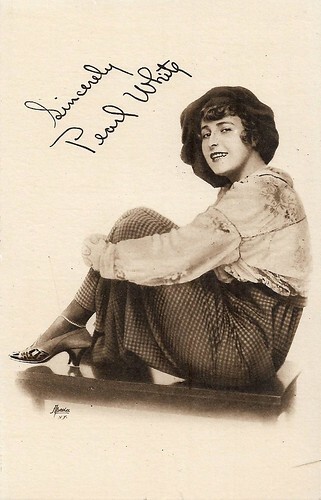
British postcard by Vandyck printers, Bristol/London. Photo: Apeda, New York.
Pearl White (1889-1938) was dubbed 'Queen of the Serials", and noted for doing her own stunts, in silent film serials such as The Perils of Pauline (1914) and The Exploits of Elaine (1914-1915). Many episodes ended with a literal cliffhanger. In Europe, The Exploits of Elaine was re-edited with two subsequent serials into Les Mystères de New York. Until the end of the First World War White remained globally a popular action heroine.
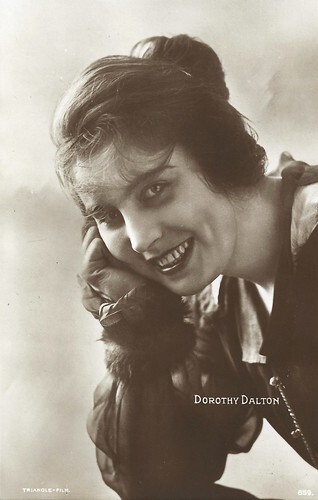
Swedish postcard by Förlag Nordisk Konst, Stockholm, no. 659. Photo by Apeda (Alexander W. Dreyfoos) / Triangle Film.
Dorothy Dalton (1893-1972) was an American actress on the silent screen, at Kay-Bee, Thomas Ince Corp, and Famous Players/ Paramount. In the early 1920s, she was a huge film star.
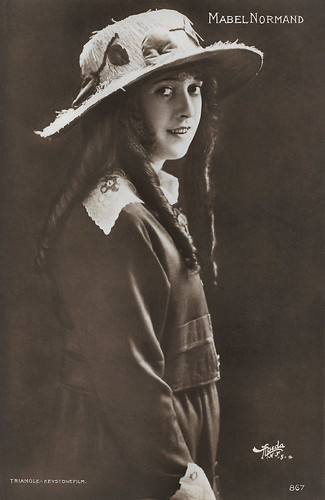
Swedish postcard by Förlag Nordisk Konst, Stockholm, no. 867. Photo: Apeda N.Y. / Triangle-Keystone Films.
Mabel Normand (1892-1930) was a popular American silent film comedienne, in particular in her films with Charlie Chaplin. But alcohol, drugs, and scandal wrecked her career and TBC killed her at a young age.
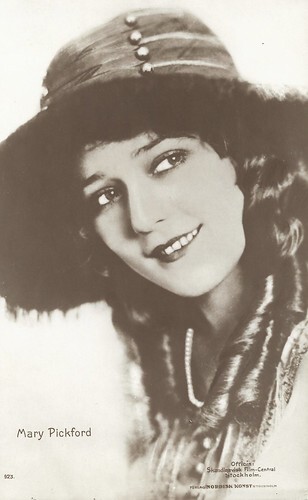
Swedish postcard by Förlag Nordisk Konst, Stockholm, no. 923. Photo: Apeda / Skandinavisk Film-Central, Stockholm.
Mary Pickford (1892-1979) was a legendary silent film actress who was known as 'America’s Sweetheart.' She was a founder of United Artists and helped establish the Academy.
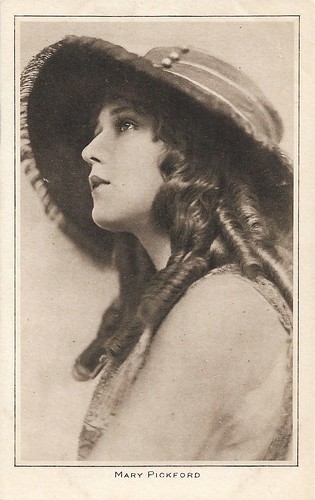
British postcard in the 'Pictures' Portrait Gallery, London. Photo: Apeda.
Mary Pickford (1892-1979) was a legendary silent film actress who was known as 'America’s Sweetheart.' She founded United Artists and helped establish the Academy.
A landmark copyright case
The Apeda Studio was in business in New York City from 1906 to 1990. With its industrial developers and mechanised postcard printers, the Apeda Studio was an immediate success. Like many studios servicing the theatrical community, Apeda, and its staff of photographers sold prints to the general public of their sitters. They also bought up the negatives of their competitors and made copies of photographs distributed by other photo studios, going so far as to remove other studio logos and replace them with the Apeda mark.
In 1912 Apeda began selling copies of White Studio's production stills for The Chorus Lady, A Gentleman of Leisure, Gentleman from Mississippi, and Thais under the Apeda name. In 1913, Apeda won the ensuing lawsuit, White Studio v. Dreyfoos, in a landmark copyright case. The decision rested on the court's understanding of work for hire. If an actor hired White Studio to produce a portrait, there was nothing prohibiting him from going to Apeda to reproduce that image in hundreds of copies at a lower cost than White would charge, since the actor himself holds the portrait copyright.
Like Underwood & Underwood, Apeda would buy up the entire production archive of photographers who had business difficulties or were moving to other parts of the country. Apeda, for instance, bought up the negatives of the Geisler-Andrews firm after the partners split. In the 1920s, Obstfeld surrendered the business management to Harold Danziger, whose background was in theatre management. Dreyfoos remained head photographer, lensing sittings himself, and overseeing a small staff of event photographers and college yearbook portraitists.
The several photographers who contracted for work with Apeda over the years were conversant in every contemporary portrait style, often imitating signal features of high-profile photographers of the day. If there was any discernible ability characteristic of the company's photography, it was the ability to portray the whole body of the subject. Apeda's photo of Bert Errol in drag was featured on a postcard. It also published a photograph of minstrel performers in blackface. While whole-body portraiture was normal in sports and dance photography, it grew infrequent in 1920s theatrical portraiture, with whole-body shots being associated with production stills. Apeda photographers bucked the trend, producing whole-body non-production portraiture after it went out of fashion in Manhattan.
During the mid-1930s and 1940s, Apeda left off performing arts work, turning to advertising imagery, industrial photography, high school class portraiture, and Armed Services portraiture. In the later 20th century, it was reorganized as Apco Apeda and operated until the 1990s when its New York headquarters encountered difficulties with the Environmental Protection Agency for chemical pollution. The International Center of Photography (ICP) and Library of Congress have collections of photographs from the studio.
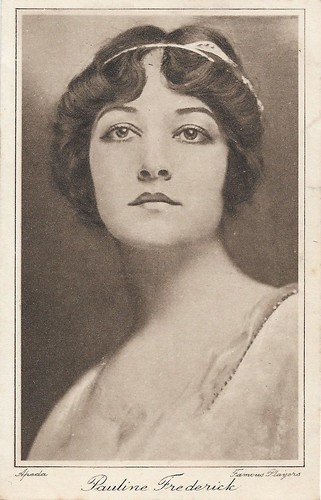
British postcard in the Cinema Chat series. Photo: Apeda / Famous Players.
Pauline Frederick (1883-1938) was an American theatre and film actress. Frederick made a name for herself in the theatre and had already passed thirty when she became successful in Hollywood. In the period of silent pictures, she was one of the most powerful actresses in the film industry.
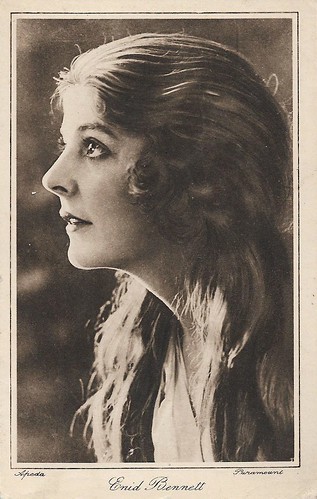
British postcard in the Cinema Chat series. Photo: Apeda / Paramount.
Enid Bennett (1893–1969) was an Australian silent film actress, mostly active in American film. She peaked in the late 1910s and early 1920s with films such as Robin Hood (1922), starring Douglas Fairbanks. In 1931 she played Jackie Coogan's mother in the Oscar-winning film Skippy. She was the wife of director Fred Niblo and after his death, director Sidney Franklin.
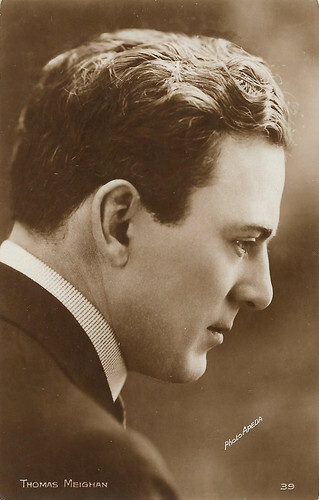
French postcard by Editions Cinémagazine, no. 39. Photo: Apeda.
Thomas Meighan (1879-1936) was an American stage and screen actor, noted for his films with directors William and Cecil B. DeMille.
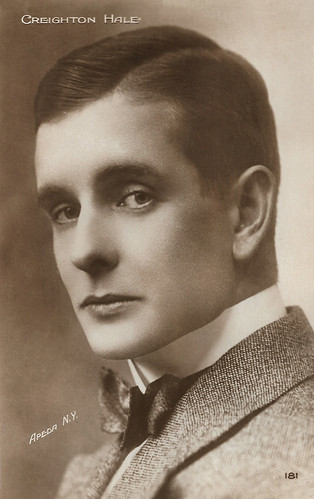
French postcard by Editions Cinémagazine, Paris, no. 181. Photo Apeda, New York.
Creighton Hale (1882–1965) was an Irish-American stage, screen, and TV actor, whose career spanned more than half a century, from the early 1900s to the end of the 1950s. From 1914, Hale worked at Pathé, having his breakthrough with the serial The Exploits of Elaine (1914), followed by the subsequent Pathé serials The New Exploits of Elaine, The Romance of Elaine, and The Iron Claw. He also provided comic sidenotes to D.W. Griffith's prestigious dramas Way Down East (1920) and Orphans of the Storm (1921), while he was Florence Vidor's unlucky suitor in the comedy The Marriage Circle (Ernst Lubitsch, 1924), the comic hero in the horror comedy The Cat and the Canary (Paul Leni, 1927), and the male lead in Benjamin Christensen's Seven Footprints to Satan (1929), released both as silent film and part-talkie.
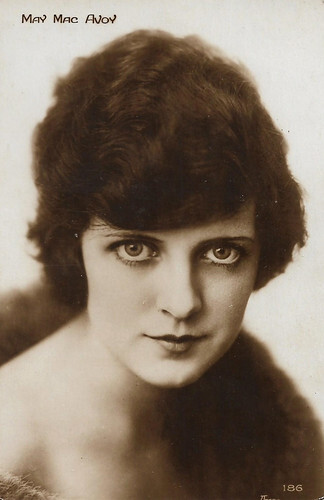
French postcard by Editions Cinémagazine, Paris, no. 186. Photo: Apeda.
May McAvoy (1899-1984) was an American actress on the silent screen, best known as Esther in Ben-Hur (Fred Niblo, 1925).
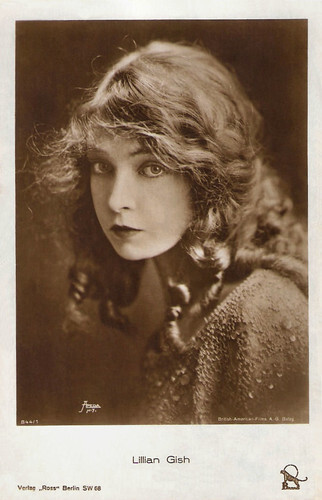
German postcard by Ross-Verlag, no. 844/1, 1925-1926. Photo: Apeda (Alexander W. Dreyfoos), New York / British-American-Films A.G. Bafag.
American actress Lillian Gish (1893-1993) was 'The First Lady of the Silent Screen'. During the 1910s, she was one of director D.W. Griffith's greatest stars. She appeared in features such as The Birth of a Nation (1915); Broken Blossoms (1919); and Orphans of the Storm (1921). After 13 years with Griffith, she moved to MGM where her first picture was La bohème (1926). In the 1940s she again appeared in a handful of films and received a Best Supporting Actress Oscar nomination for her role as Laura Belle McCanles in Duel in the Sun (1946). Her last film was The Whales of August (1987) in which she shared the lead with Bette Davis.
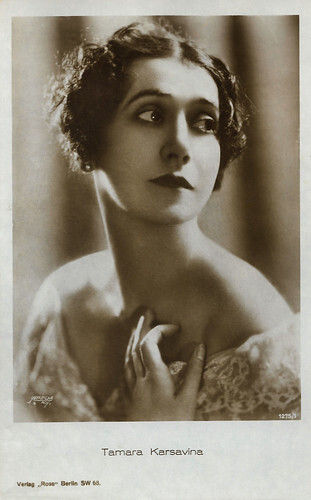
German postcard by Ross Verlag, Berlin, no. 1275/1, 1927-1928. Photo: Apeda, N.Y. (Alexander W. Dreyfoos).
Russian prima ballerina Tamara Karsavina (1885-1978) was renowned for her beauty. She was a principal artist of the Imperial Russian Ballet and later of the Ballets Russes of Sergei Diaghilev. She also appeared in a few silent films. After settling in Britain at Hampstead in London, she began teaching ballet professionally and became recognised as one of the founders of modern British ballet. She assisted in the establishment of The Royal Ballet and was a founder member of the Royal Academy of Dance, which is now the world's largest dance-teaching organisation.
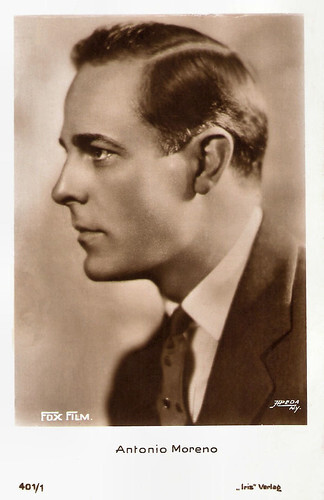
Austrian postcard by Iris Verlag, no. 401/1. Photo: Apeda (Alexander W. Dreyfoos), New York / Fox Film.
Antonio 'Tony' Moreno (1887-1967) was a Spanish-born American actor and film director of the silent film era and through the 1950s. In his early films, Moreno was often typecast as the 'Latin Lover'.
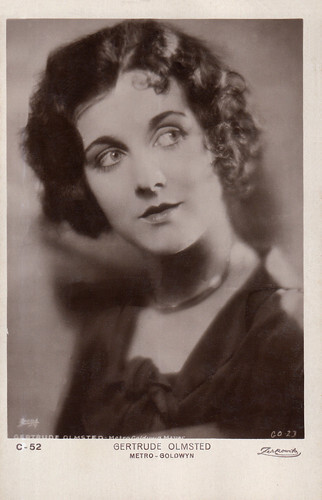
Spanish postcard by Ediciones Adolfo Zerkowitz, no. C-52. Photo: Apeda. Collection: Marlene Pilaete.
Gertrude Olmsted (1897-1975) never quite reached the first rank of Hollywood silent film stars. Nevertheless, she was in high demand in the 1920s and was featured in about sixty films. After ten years of intense activity, she decided it was time to retire and enjoy a happy married life.
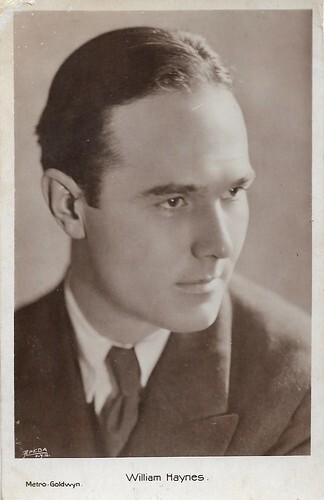
French postcard. Photo: Metro-Goldwyn / Photo by Apeda (Alexander W. Dreyfoos), New York.
William 'Billy' Haines (1900–1973) was an American film actor and interior designer. By the end of the silent era, he was regularly named as the No. 1 male box-office draw of Hollywood.
Sources: David S. Shields (Broadway Photographs), The New Found Photography, and Wikipedia.

British postcard by Vandyck printers, Bristol/London. Photo: Apeda, New York.
Pearl White (1889-1938) was dubbed 'Queen of the Serials", and noted for doing her own stunts, in silent film serials such as The Perils of Pauline (1914) and The Exploits of Elaine (1914-1915). Many episodes ended with a literal cliffhanger. In Europe, The Exploits of Elaine was re-edited with two subsequent serials into Les Mystères de New York. Until the end of the First World War White remained globally a popular action heroine.

Swedish postcard by Förlag Nordisk Konst, Stockholm, no. 659. Photo by Apeda (Alexander W. Dreyfoos) / Triangle Film.
Dorothy Dalton (1893-1972) was an American actress on the silent screen, at Kay-Bee, Thomas Ince Corp, and Famous Players/ Paramount. In the early 1920s, she was a huge film star.

Swedish postcard by Förlag Nordisk Konst, Stockholm, no. 867. Photo: Apeda N.Y. / Triangle-Keystone Films.
Mabel Normand (1892-1930) was a popular American silent film comedienne, in particular in her films with Charlie Chaplin. But alcohol, drugs, and scandal wrecked her career and TBC killed her at a young age.

Swedish postcard by Förlag Nordisk Konst, Stockholm, no. 923. Photo: Apeda / Skandinavisk Film-Central, Stockholm.
Mary Pickford (1892-1979) was a legendary silent film actress who was known as 'America’s Sweetheart.' She was a founder of United Artists and helped establish the Academy.

British postcard in the 'Pictures' Portrait Gallery, London. Photo: Apeda.
Mary Pickford (1892-1979) was a legendary silent film actress who was known as 'America’s Sweetheart.' She founded United Artists and helped establish the Academy.
A landmark copyright case
The Apeda Studio was in business in New York City from 1906 to 1990. With its industrial developers and mechanised postcard printers, the Apeda Studio was an immediate success. Like many studios servicing the theatrical community, Apeda, and its staff of photographers sold prints to the general public of their sitters. They also bought up the negatives of their competitors and made copies of photographs distributed by other photo studios, going so far as to remove other studio logos and replace them with the Apeda mark.
In 1912 Apeda began selling copies of White Studio's production stills for The Chorus Lady, A Gentleman of Leisure, Gentleman from Mississippi, and Thais under the Apeda name. In 1913, Apeda won the ensuing lawsuit, White Studio v. Dreyfoos, in a landmark copyright case. The decision rested on the court's understanding of work for hire. If an actor hired White Studio to produce a portrait, there was nothing prohibiting him from going to Apeda to reproduce that image in hundreds of copies at a lower cost than White would charge, since the actor himself holds the portrait copyright.
Like Underwood & Underwood, Apeda would buy up the entire production archive of photographers who had business difficulties or were moving to other parts of the country. Apeda, for instance, bought up the negatives of the Geisler-Andrews firm after the partners split. In the 1920s, Obstfeld surrendered the business management to Harold Danziger, whose background was in theatre management. Dreyfoos remained head photographer, lensing sittings himself, and overseeing a small staff of event photographers and college yearbook portraitists.
The several photographers who contracted for work with Apeda over the years were conversant in every contemporary portrait style, often imitating signal features of high-profile photographers of the day. If there was any discernible ability characteristic of the company's photography, it was the ability to portray the whole body of the subject. Apeda's photo of Bert Errol in drag was featured on a postcard. It also published a photograph of minstrel performers in blackface. While whole-body portraiture was normal in sports and dance photography, it grew infrequent in 1920s theatrical portraiture, with whole-body shots being associated with production stills. Apeda photographers bucked the trend, producing whole-body non-production portraiture after it went out of fashion in Manhattan.
During the mid-1930s and 1940s, Apeda left off performing arts work, turning to advertising imagery, industrial photography, high school class portraiture, and Armed Services portraiture. In the later 20th century, it was reorganized as Apco Apeda and operated until the 1990s when its New York headquarters encountered difficulties with the Environmental Protection Agency for chemical pollution. The International Center of Photography (ICP) and Library of Congress have collections of photographs from the studio.

British postcard in the Cinema Chat series. Photo: Apeda / Famous Players.
Pauline Frederick (1883-1938) was an American theatre and film actress. Frederick made a name for herself in the theatre and had already passed thirty when she became successful in Hollywood. In the period of silent pictures, she was one of the most powerful actresses in the film industry.

British postcard in the Cinema Chat series. Photo: Apeda / Paramount.
Enid Bennett (1893–1969) was an Australian silent film actress, mostly active in American film. She peaked in the late 1910s and early 1920s with films such as Robin Hood (1922), starring Douglas Fairbanks. In 1931 she played Jackie Coogan's mother in the Oscar-winning film Skippy. She was the wife of director Fred Niblo and after his death, director Sidney Franklin.

French postcard by Editions Cinémagazine, no. 39. Photo: Apeda.
Thomas Meighan (1879-1936) was an American stage and screen actor, noted for his films with directors William and Cecil B. DeMille.

French postcard by Editions Cinémagazine, Paris, no. 181. Photo Apeda, New York.
Creighton Hale (1882–1965) was an Irish-American stage, screen, and TV actor, whose career spanned more than half a century, from the early 1900s to the end of the 1950s. From 1914, Hale worked at Pathé, having his breakthrough with the serial The Exploits of Elaine (1914), followed by the subsequent Pathé serials The New Exploits of Elaine, The Romance of Elaine, and The Iron Claw. He also provided comic sidenotes to D.W. Griffith's prestigious dramas Way Down East (1920) and Orphans of the Storm (1921), while he was Florence Vidor's unlucky suitor in the comedy The Marriage Circle (Ernst Lubitsch, 1924), the comic hero in the horror comedy The Cat and the Canary (Paul Leni, 1927), and the male lead in Benjamin Christensen's Seven Footprints to Satan (1929), released both as silent film and part-talkie.

French postcard by Editions Cinémagazine, Paris, no. 186. Photo: Apeda.
May McAvoy (1899-1984) was an American actress on the silent screen, best known as Esther in Ben-Hur (Fred Niblo, 1925).

German postcard by Ross-Verlag, no. 844/1, 1925-1926. Photo: Apeda (Alexander W. Dreyfoos), New York / British-American-Films A.G. Bafag.
American actress Lillian Gish (1893-1993) was 'The First Lady of the Silent Screen'. During the 1910s, she was one of director D.W. Griffith's greatest stars. She appeared in features such as The Birth of a Nation (1915); Broken Blossoms (1919); and Orphans of the Storm (1921). After 13 years with Griffith, she moved to MGM where her first picture was La bohème (1926). In the 1940s she again appeared in a handful of films and received a Best Supporting Actress Oscar nomination for her role as Laura Belle McCanles in Duel in the Sun (1946). Her last film was The Whales of August (1987) in which she shared the lead with Bette Davis.

German postcard by Ross Verlag, Berlin, no. 1275/1, 1927-1928. Photo: Apeda, N.Y. (Alexander W. Dreyfoos).
Russian prima ballerina Tamara Karsavina (1885-1978) was renowned for her beauty. She was a principal artist of the Imperial Russian Ballet and later of the Ballets Russes of Sergei Diaghilev. She also appeared in a few silent films. After settling in Britain at Hampstead in London, she began teaching ballet professionally and became recognised as one of the founders of modern British ballet. She assisted in the establishment of The Royal Ballet and was a founder member of the Royal Academy of Dance, which is now the world's largest dance-teaching organisation.

Austrian postcard by Iris Verlag, no. 401/1. Photo: Apeda (Alexander W. Dreyfoos), New York / Fox Film.
Antonio 'Tony' Moreno (1887-1967) was a Spanish-born American actor and film director of the silent film era and through the 1950s. In his early films, Moreno was often typecast as the 'Latin Lover'.

Spanish postcard by Ediciones Adolfo Zerkowitz, no. C-52. Photo: Apeda. Collection: Marlene Pilaete.
Gertrude Olmsted (1897-1975) never quite reached the first rank of Hollywood silent film stars. Nevertheless, she was in high demand in the 1920s and was featured in about sixty films. After ten years of intense activity, she decided it was time to retire and enjoy a happy married life.

French postcard. Photo: Metro-Goldwyn / Photo by Apeda (Alexander W. Dreyfoos), New York.
William 'Billy' Haines (1900–1973) was an American film actor and interior designer. By the end of the silent era, he was regularly named as the No. 1 male box-office draw of Hollywood.
Sources: David S. Shields (Broadway Photographs), The New Found Photography, and Wikipedia.
Published on April 15, 2025 22:00
April 14, 2025
15 more cards from G.D.I.
In our monthly post on the Geoffrey Donaldson Institute (GDI), we chose 15 postcards from a big album from the estate of film historians Tjitte de Vries and Ati Mul. It's an album which they probably started somewhere in the 1970s with interesting postcards from several periods and several countries. We start today with a selection of the eldest postcards from the album.
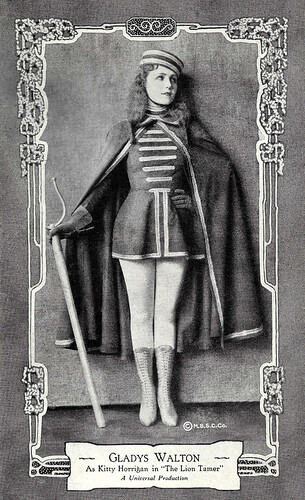
American postcard by Max B. Sheffer Card Co., Chicago (M.B.S.C.Co.). Photo: Universal. Gladys Walton in The Man Tamer (Harry B. Harris, 1921).
Gladys Walton (1903-1993) was an American actress, who peaked in the American silent film of the 1920s. She was a flapper in such films such as The Girl Who Ran Wild (1922), and The Wise Kid (1922).
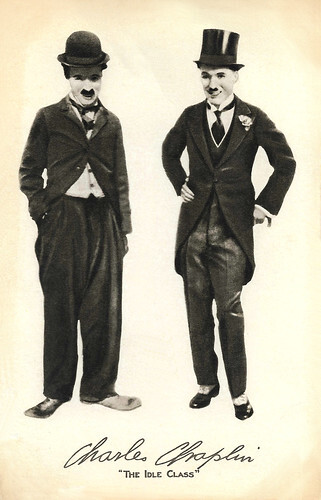
British postcard. Charlie Chaplin in The Idle Class (Charles Chaplin, 1921).
English comedian Charles ‘Charlie’ Chaplin (1889-1977) was one of the most creative and influential personalities of the silent-film era. His most famous role was that of The Tramp with his toothbrush moustache, undersized bowler hat and bamboo cane who struggled to survive while keeping his dignity in a world with great social injustice. Chaplin used mime, slapstick and other visual comedy routines, and he not only starred in his films, but also directed, wrote and produced them, and composed the music as well. His working life in entertainment spanned over 75 years, from the Victorian stage and the Music Hall in the United Kingdom as a child performer, until close to his death at the age of 88. Author George Bernard Shaw called Chaplin "the only genius to come out of the movie industry".
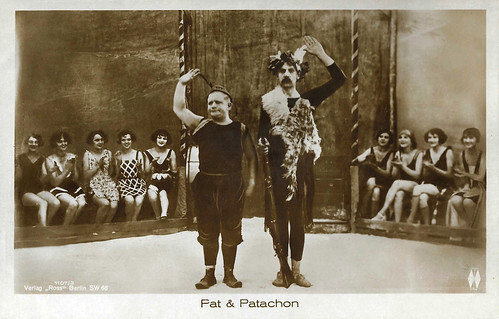
German postcard by Ross Verlag, no. 1107/3, 1927-1928. Photo: Bayerische Film-G.m.b.H. / Palladium Film. Pat and Patachon (Fy og Bi) in the Danish silent comedy Takt, Tone og Tosser/The Bilberries/ Pat und Patachon im Zirkus (Lau Lauritzen, 1925).
The Danish double-act Fy og Bi (Fyrtårnet og Bivognen a.k.a. Pat & Patachon) was the most famous comedy couple of the European silent cinema. Long Carl Schenstrom (1881-1942) and short Harald Madsen (1890-1949) became very popular in the 1920s with their short slapstick films.
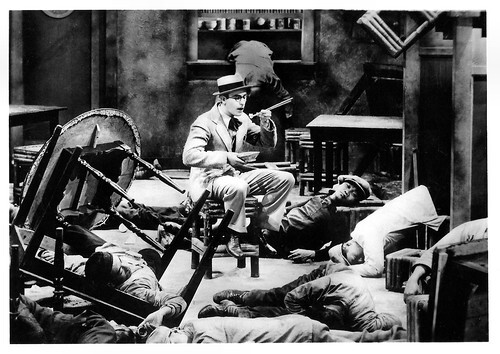
French postcard in the Burelesques series by Librairie de la Fontaine, Paris, no. 2. Harold Lloyd in Welcome Danger (Clyde Bruckman, Malcolm St. Clair, 1929).
American actor, comedian, director, producer, screenwriter, and stunt performer Harold Lloyd (1893-1971) is best known for his silent comedies. He ranks alongside Charlie Chaplin and Buster Keaton as one of the three most popular and influential comedians of silent film. Between 1914 and 1947, Lloyd made nearly 200 comedies, often as a bespectacled 'Glass' character, a resourceful, success-seeking go-getter who was perfectly in tune with the 1920s-era United States. His films frequently contained 'thrill sequences' of extended chase scenes and daredevil physical feats. A classic is Lloyd hanging from the hands of a clock high above the street in Safety Last! (1923).
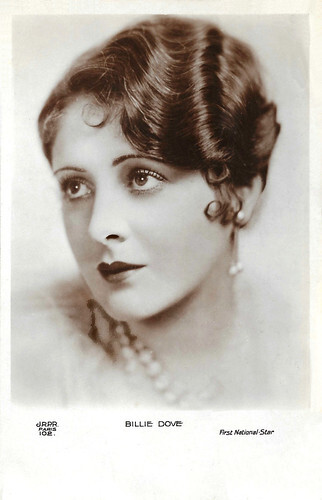
French postcard by J.R.P.R., Paris, no. 102. Photo: First National.
Stunningly beautiful and highly photogenic Billie Dove (1903-1997) was one of the most popular Hollywood actresses of the 1920s. She was dubbed The American Beauty, after the title of one of her films.
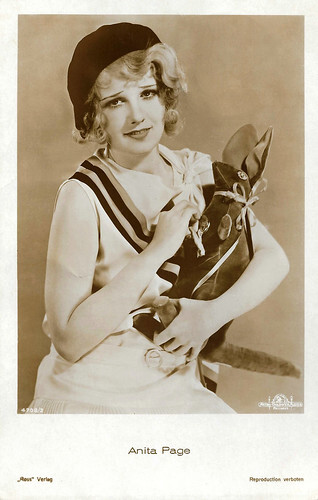
German postcard by Ross Verlag, no. 4709/2, 1929-1930. Photo: Metro Goldwyn Mayer.
Beautiful Anita Page (1910–2008) was one of the most popular leading ladies of Hollywood during the last years of the silent screen and the first years of the sound era. According to MGM, she received the most fan mail at the time and her nickname was "the girl with the most beautiful face in Hollywood".
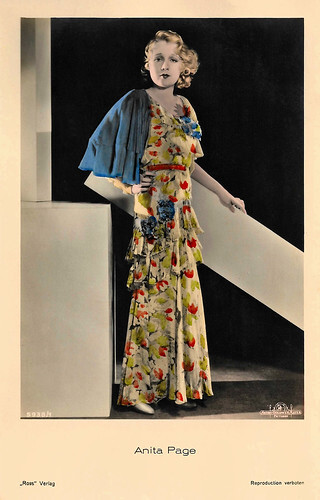
German postcard by Ross Verlag, no. 5938/1, 1930-1931. Photo: Metro Goldwyn Mayer.
Who were Tjitte de Vries and Ati Mul?
Dutch film journalist and researcher Tjitte de Vries (1938-2015) and his life partner Ati Mul (1947-2022) were true cinephiles and collectors. Tjitte de Vries worked as a film expert from the 1960s to the 1990s and wrote reviews in several newspapers, including Het Parool and the former Het Vrije Volk.
He published the booklet 'Tien Jaar Holland Animation: Rembrandt’s filmende erfgenamen' (Ten years of Holland Animation: Rembrandt's filming heirs, 1983) and together with Ati Mul, the article 'Joop Geesink, poppenfilmproducent' ( Joop Geesink , puppet film producer, 1984) in Animatie magazine, largely based on interviews with former employees of the Geesink studio.
After De Vries's work for the newspapers ended, he and Mul embarked on their most important, internationally prominent research project. The subject was the British photographer and film pioneer Arthur Melbourne-Cooper, best known for his application of stop-motion techniques.
They published 'Arthur Melbourne-Cooper, Film Pioneer Wronged by History' (1994), 'A Documentation of Sources' (2004) and the book 'They Thought It Was a Marvel. Arthur Melbourne-Cooper (1874-1961), Pioneer of Puppet Animation' (2009). Until her death, Ati Mul continued working on a new publication on Melbourne-Cooper and managing the collections of information and equipment in her home.
Part of their huge private collection was transferred to Stichting Vrienden van het Filmarchief (Foundation Friends of the Film Archive) in 1991 and eventually ended up at the University of Groningen and Eye. The inventory included 83 35mm films, 449 16mm films, 293 documentaries, 216 negatives, 2,000 posters, 136 cameras and 103 projectors. They also donated photographs and posters to the Geoffrey Donaldson Institute, including this album with film postcards.
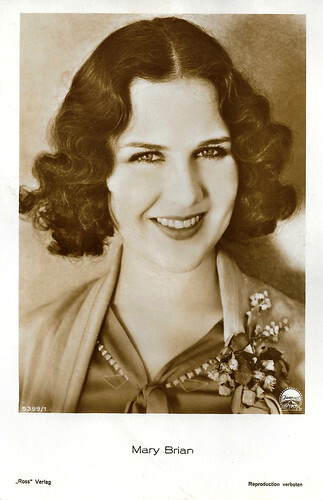
German postcard by Ross Verlag, no. 5399/1, 1930-1931. Photo: Paramount.
Mary Brian (1906-2002) was an American actress and film star with dark brown curls and blue/grey eyes, who made the transition from silent films to sound films. She was dubbed 'The Sweetest Girl in Pictures'.
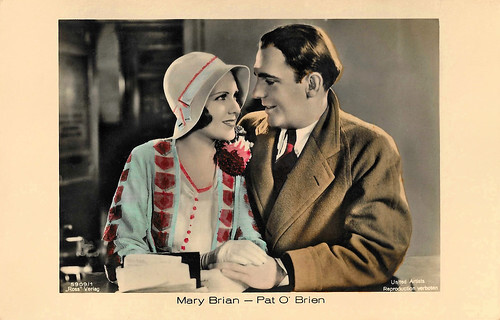
German postcard by Ross Verlag, no. 5909/1, 1930-1931. Photo: United Artists. Mary Brian and Pat 'O Brien in The Front Page (Lewis Milestone, 1931).
Pat O'Brien (1899-1983) was an American actor of Irish descent. From 1930 on, he starred in around 150 films. He often starred alongside the actor James Cagney. He is best known for his roles in The Cowboy from Brooklyn (1938), Knute Rockne, All American (1940) and Some Like It Hot (1959).
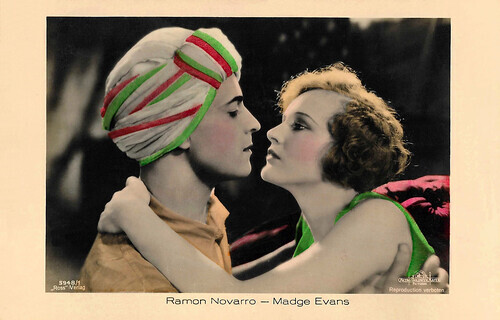
German postcard by Ross Verlag, no. 5948/1, 1930-1931. Photo: Metro-Goldwyn-Mayer. Ramon Novarro and Madge Evans in Son of India (Jacques Feyder, 1931).
Mexican-American actor Ramon Novarro (1899-1968) was a popular Latin Lover of the 1920s and early 1930s MGM films. He was the star of silent Hollywood's biggest epic, Ben-Hur (1925).
Lovely Madge Evans (1909-1981) was an American stage and film actress, who often played the 'nice' girl in Hollywood films of the 1930s. She began her career as a child performer and model, starting with Fairy Soap commercials at the age of two.
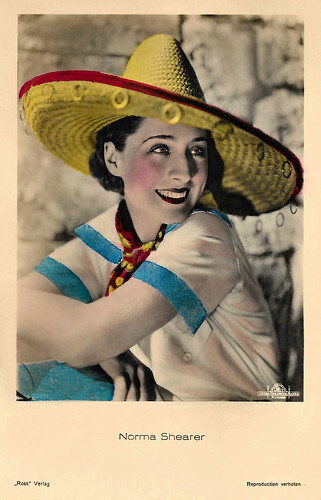
German postcard by Ross Verlag, no. 5234/1, 1930-1931. Photo: George Hurrell / Metro-Goldwyn-Mayer.
American actress Norma Shearer (1902-1983) was the 'First Lady of MGM'. She often played spunky, sexually liberated ingenues, and was the first person to be nominated five times for an Academy Award for acting. Shearer won the Best Actress Oscar for The Divorcee (1930).
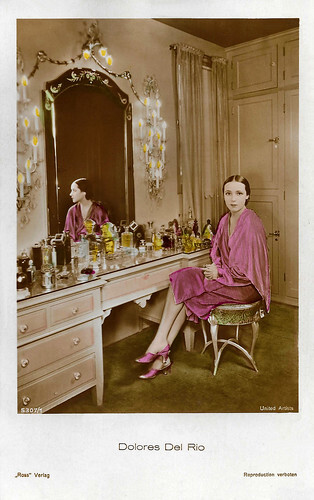
German postcard by Ross Verlag, no. 5307/1, 1931-1932. Photo: United Artists.
Mexican and American actress Dolores del Río (1905–1983) was a Hollywood star in the 1920s and 1930s, and one of the most important female actresses of the Golden Age of Mexican cinema in the 1940s and 1950s. Del Río was the first major Latin cross-over star in Hollywood and was considered one of the most beautiful faces that have emerged in Hollywood cinema. She also appeared in several European films.
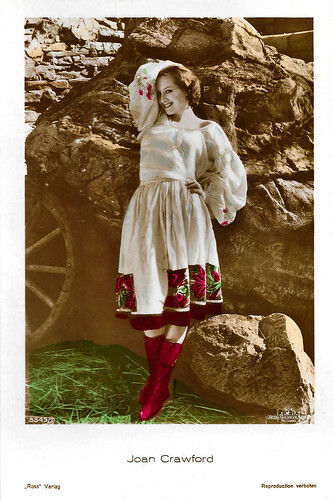
German postcard by Ross Verlag, no. 5349/1, 1930-1931. Photo: MGM.
American film star Joan Crawford (1904-1977) had a career that would span many decades, studios, and controversies. In her silent films, she made an impact as a vivacious Jazz Age flapper and later she matured into a star of psychological melodramas.
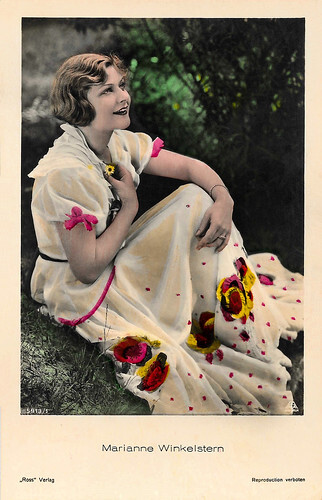
German postcard by Ross Verlag, no. 5913/1, 1930-1931. Photo: Aafa-Film.
German dancer and actress Marianne Winkelstern (1910-1966) became well-known as a ballerina in Germany and England. In Germany, she appeared in some silent films and early sound films.
s Jazz Age flapper and later she matured into a star of psychological melodramas.
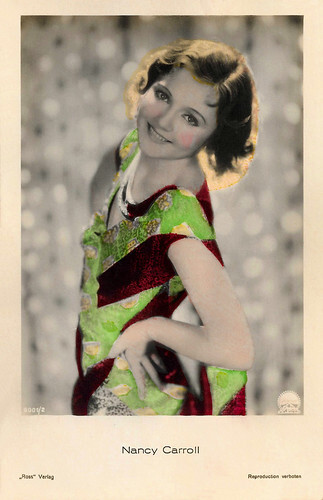
German postcard by Ross Verlag, no. 6001/2, 1931-1932. Photo: Paramount.
Red-haired, cupid-bow-mouthed Nancy Carroll (1903-1965) became a very popular Hollywood star upon the advent of sound film because of her singing and dancing abilities. She was reported to have received more fan mail than any of her Hollywood peers of the same era. As she expanded her acting range from flaming flapper to ditzy comedienne to sensitive heroine, she was nominated for an Oscar for The Devil's Holiday (1930).
Sources: Mariska Graveland (Eye), Hans Beerekamp (Het Schimmenrijk, 2015) and Jim Postma (Rotterdam vandaag & morgen - Dutch). All postcards: Collection: Geoffrey Donaldson Institute. Next post on 15 May 2025.

American postcard by Max B. Sheffer Card Co., Chicago (M.B.S.C.Co.). Photo: Universal. Gladys Walton in The Man Tamer (Harry B. Harris, 1921).
Gladys Walton (1903-1993) was an American actress, who peaked in the American silent film of the 1920s. She was a flapper in such films such as The Girl Who Ran Wild (1922), and The Wise Kid (1922).

British postcard. Charlie Chaplin in The Idle Class (Charles Chaplin, 1921).
English comedian Charles ‘Charlie’ Chaplin (1889-1977) was one of the most creative and influential personalities of the silent-film era. His most famous role was that of The Tramp with his toothbrush moustache, undersized bowler hat and bamboo cane who struggled to survive while keeping his dignity in a world with great social injustice. Chaplin used mime, slapstick and other visual comedy routines, and he not only starred in his films, but also directed, wrote and produced them, and composed the music as well. His working life in entertainment spanned over 75 years, from the Victorian stage and the Music Hall in the United Kingdom as a child performer, until close to his death at the age of 88. Author George Bernard Shaw called Chaplin "the only genius to come out of the movie industry".

German postcard by Ross Verlag, no. 1107/3, 1927-1928. Photo: Bayerische Film-G.m.b.H. / Palladium Film. Pat and Patachon (Fy og Bi) in the Danish silent comedy Takt, Tone og Tosser/The Bilberries/ Pat und Patachon im Zirkus (Lau Lauritzen, 1925).
The Danish double-act Fy og Bi (Fyrtårnet og Bivognen a.k.a. Pat & Patachon) was the most famous comedy couple of the European silent cinema. Long Carl Schenstrom (1881-1942) and short Harald Madsen (1890-1949) became very popular in the 1920s with their short slapstick films.

French postcard in the Burelesques series by Librairie de la Fontaine, Paris, no. 2. Harold Lloyd in Welcome Danger (Clyde Bruckman, Malcolm St. Clair, 1929).
American actor, comedian, director, producer, screenwriter, and stunt performer Harold Lloyd (1893-1971) is best known for his silent comedies. He ranks alongside Charlie Chaplin and Buster Keaton as one of the three most popular and influential comedians of silent film. Between 1914 and 1947, Lloyd made nearly 200 comedies, often as a bespectacled 'Glass' character, a resourceful, success-seeking go-getter who was perfectly in tune with the 1920s-era United States. His films frequently contained 'thrill sequences' of extended chase scenes and daredevil physical feats. A classic is Lloyd hanging from the hands of a clock high above the street in Safety Last! (1923).

French postcard by J.R.P.R., Paris, no. 102. Photo: First National.
Stunningly beautiful and highly photogenic Billie Dove (1903-1997) was one of the most popular Hollywood actresses of the 1920s. She was dubbed The American Beauty, after the title of one of her films.

German postcard by Ross Verlag, no. 4709/2, 1929-1930. Photo: Metro Goldwyn Mayer.
Beautiful Anita Page (1910–2008) was one of the most popular leading ladies of Hollywood during the last years of the silent screen and the first years of the sound era. According to MGM, she received the most fan mail at the time and her nickname was "the girl with the most beautiful face in Hollywood".

German postcard by Ross Verlag, no. 5938/1, 1930-1931. Photo: Metro Goldwyn Mayer.
Who were Tjitte de Vries and Ati Mul?
Dutch film journalist and researcher Tjitte de Vries (1938-2015) and his life partner Ati Mul (1947-2022) were true cinephiles and collectors. Tjitte de Vries worked as a film expert from the 1960s to the 1990s and wrote reviews in several newspapers, including Het Parool and the former Het Vrije Volk.
He published the booklet 'Tien Jaar Holland Animation: Rembrandt’s filmende erfgenamen' (Ten years of Holland Animation: Rembrandt's filming heirs, 1983) and together with Ati Mul, the article 'Joop Geesink, poppenfilmproducent' ( Joop Geesink , puppet film producer, 1984) in Animatie magazine, largely based on interviews with former employees of the Geesink studio.
After De Vries's work for the newspapers ended, he and Mul embarked on their most important, internationally prominent research project. The subject was the British photographer and film pioneer Arthur Melbourne-Cooper, best known for his application of stop-motion techniques.
They published 'Arthur Melbourne-Cooper, Film Pioneer Wronged by History' (1994), 'A Documentation of Sources' (2004) and the book 'They Thought It Was a Marvel. Arthur Melbourne-Cooper (1874-1961), Pioneer of Puppet Animation' (2009). Until her death, Ati Mul continued working on a new publication on Melbourne-Cooper and managing the collections of information and equipment in her home.
Part of their huge private collection was transferred to Stichting Vrienden van het Filmarchief (Foundation Friends of the Film Archive) in 1991 and eventually ended up at the University of Groningen and Eye. The inventory included 83 35mm films, 449 16mm films, 293 documentaries, 216 negatives, 2,000 posters, 136 cameras and 103 projectors. They also donated photographs and posters to the Geoffrey Donaldson Institute, including this album with film postcards.

German postcard by Ross Verlag, no. 5399/1, 1930-1931. Photo: Paramount.
Mary Brian (1906-2002) was an American actress and film star with dark brown curls and blue/grey eyes, who made the transition from silent films to sound films. She was dubbed 'The Sweetest Girl in Pictures'.

German postcard by Ross Verlag, no. 5909/1, 1930-1931. Photo: United Artists. Mary Brian and Pat 'O Brien in The Front Page (Lewis Milestone, 1931).
Pat O'Brien (1899-1983) was an American actor of Irish descent. From 1930 on, he starred in around 150 films. He often starred alongside the actor James Cagney. He is best known for his roles in The Cowboy from Brooklyn (1938), Knute Rockne, All American (1940) and Some Like It Hot (1959).

German postcard by Ross Verlag, no. 5948/1, 1930-1931. Photo: Metro-Goldwyn-Mayer. Ramon Novarro and Madge Evans in Son of India (Jacques Feyder, 1931).
Mexican-American actor Ramon Novarro (1899-1968) was a popular Latin Lover of the 1920s and early 1930s MGM films. He was the star of silent Hollywood's biggest epic, Ben-Hur (1925).
Lovely Madge Evans (1909-1981) was an American stage and film actress, who often played the 'nice' girl in Hollywood films of the 1930s. She began her career as a child performer and model, starting with Fairy Soap commercials at the age of two.

German postcard by Ross Verlag, no. 5234/1, 1930-1931. Photo: George Hurrell / Metro-Goldwyn-Mayer.
American actress Norma Shearer (1902-1983) was the 'First Lady of MGM'. She often played spunky, sexually liberated ingenues, and was the first person to be nominated five times for an Academy Award for acting. Shearer won the Best Actress Oscar for The Divorcee (1930).

German postcard by Ross Verlag, no. 5307/1, 1931-1932. Photo: United Artists.
Mexican and American actress Dolores del Río (1905–1983) was a Hollywood star in the 1920s and 1930s, and one of the most important female actresses of the Golden Age of Mexican cinema in the 1940s and 1950s. Del Río was the first major Latin cross-over star in Hollywood and was considered one of the most beautiful faces that have emerged in Hollywood cinema. She also appeared in several European films.

German postcard by Ross Verlag, no. 5349/1, 1930-1931. Photo: MGM.
American film star Joan Crawford (1904-1977) had a career that would span many decades, studios, and controversies. In her silent films, she made an impact as a vivacious Jazz Age flapper and later she matured into a star of psychological melodramas.

German postcard by Ross Verlag, no. 5913/1, 1930-1931. Photo: Aafa-Film.
German dancer and actress Marianne Winkelstern (1910-1966) became well-known as a ballerina in Germany and England. In Germany, she appeared in some silent films and early sound films.
s Jazz Age flapper and later she matured into a star of psychological melodramas.

German postcard by Ross Verlag, no. 6001/2, 1931-1932. Photo: Paramount.
Red-haired, cupid-bow-mouthed Nancy Carroll (1903-1965) became a very popular Hollywood star upon the advent of sound film because of her singing and dancing abilities. She was reported to have received more fan mail than any of her Hollywood peers of the same era. As she expanded her acting range from flaming flapper to ditzy comedienne to sensitive heroine, she was nominated for an Oscar for The Devil's Holiday (1930).
Sources: Mariska Graveland (Eye), Hans Beerekamp (Het Schimmenrijk, 2015) and Jim Postma (Rotterdam vandaag & morgen - Dutch). All postcards: Collection: Geoffrey Donaldson Institute. Next post on 15 May 2025.
Published on April 14, 2025 22:00
April 13, 2025
Britt Ekland
Swedish actress Britt Ekland (1942) became famous through her marriage to Peter Sellers and her relationship with singer Rod Stewart. The platinum blonde was also known for her roles in more than 40 international films including The Night They Raided Minsky's (1968), Get Carter (1971), and the James Bond adventure The Man with the Golden Gun (1974).
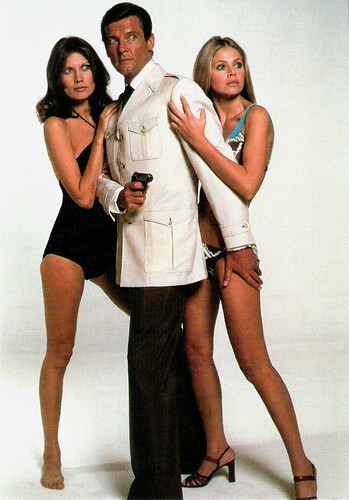
Dutch postcard by Loeb Uitgevers BV, Amsterdam, 1985. Photo: Eon Productions / Gilrose Publications / Danjaq S.A. Roger Moore , Maud Adams and Britt Ekland in The Man with the Golden Gun (Guy Hamilton, 1974).
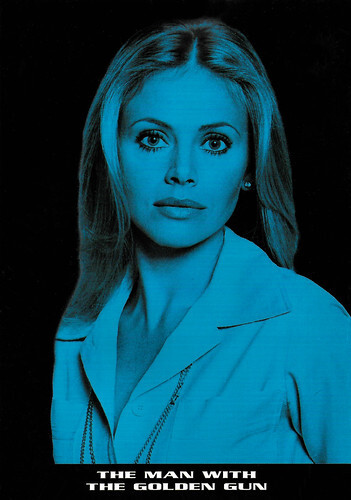
Vintage postcard in the Bond Girls series. Britt Ekland in The Man With the Golden Gun (Guy Hamilton, 1974).
The poster girl for beautiful, big-eyed Scandinavian blondes
Britt Ekland was born Britt-Marie Eklund in Stockholm, Sweden, in 1942. Her parents were Eva Maria Birgitta Löwgren, a secretary, and Sven Axel Tankred Eklund, who ran an upmarket clothing store in Stockholm and was captain of the Swedish national curling team, four-time national champion and one-time president of the World Curling Federation. She had a brother, Carl Eklund. Britt grew up to be the poster girl for beautiful, big-eyed Scandinavian blondes. She studied at the Calle Flygare Theatre School. After her studies, she was hired by Povel Ramel to participate in his travelling theatre group Knäppupprevyer. In Italy, she was spotted in a coffee shop by a talent agent who sent her to London to audition for films.
Ekland had small roles in the Swedish films Kort är sommaren / Summer is Short (Bjarne Henning-Jensen, 1962) with Jarl Kulle and Bibi Andersson , and Det är hos mig han har varit / It Is With Me That He Has Been (Arne Mattsson, 1963), before landing her a small part in the Western Advance to the Rear (George Marshall, 1964) starring Glenn Ford . When Peter Sellers met her in a hotel, he fell hard for her and they wed just 10 days after meeting. While on their honeymoon in Hollywood, Peter inhaled amyl nitrites during sex, causing a series of eight heart attacks. Sellers was rushed to the hospital but survived.
Tony Fontana at IMDb : "The combination of Sellers' stardom and her stunning beauty contributed to her fame (the fact that Sellers suffered a heart attack in bed on their wedding night did not hurt, either). " In 1965, the couple had a daughter, Victoria. Once the baby is born, their relationship becomes strained. Sellers and Ekland made three films together. In 1964 they appeared in the American Christmas television film A Carol for Another Christmas (Joseph L. Mankiewicz, 1964). They followed this with the enjoyable Italian farce Caccia alla volpe / After the Fox (Vittorio De Sica, 1966), written by Neil Simon. Their last film together was the British comedy The Bobo (Robert Parrish, 1967). The couple divorced as early as 1968.
Britt Ekland's claim to fame came as the young Amish girl who invented the striptease in the musical comedy The Night They Raided Minsky's (William Friedkin, 1968) with Jason Robards, which established her as a sex symbol. Throughout the 1960s she played major roles in The Double Man (Franklin J. Schaffner, 1967) opposite Yul Brynner , the Italian crime film Gli intoccabili / Machine Gun McCain (Giuliano Montaldo, 1969) with John Cassavetes, and the crime film Stiletto (Bernard L. Kowalski, 1969), based on a novel by Harold Robbins.
Britt Ekland had a son, Nicolai Adler (1973), with record and film producer Lou Adler. She had several other relationships with well-known figures such as pop singer Rod Stewart. They were introduced in 1975 by Joan Collins and lived together for more than two years, with Ekland giving up her career to focus on their relationship. In 1976 Ekland provided the French-spoken part at the end of Stewart's single 'Tonight's the Night (Gonna Be Alright)'. It was 1977's overall #1 song. From 1979 to 1981, she dated and became engaged to singer Phil Lewis of the groups Girl and L.A. Guns. In 1984, at age 42, she married a second time, this time to Slim Jim Phantom, drummer of the Stray Cats, who was 23. They had a son, Thomas Jefferson, in 1988. The couple divorced in 1992.
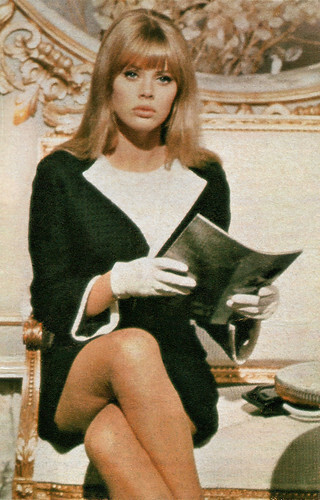
Vintage postcard.
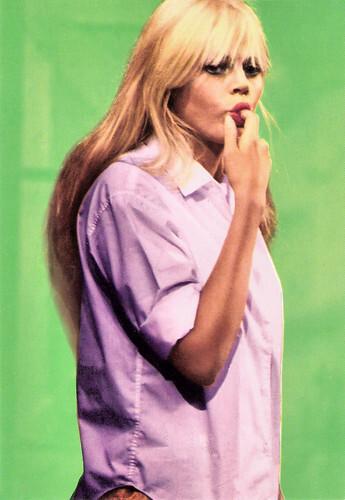
Vintage postcard.
Mary Goodnight
Britt Ekland appeared opposite Michael Caine in the classic British crime film Get Carter (Mike Hodges, 1971). She also starred in several Horror films, including the cult classic The Wicker Man (Robin Hardy, 1973).
Ekland had already auditioned to play a Bond girl in the first Bond film Dr No (1962), but the role eventually went to Ursula Andress . She finally played Bond girl Mary Goodnight in the James Bond film The Man with the Golden Gun (Guy Hamilton, 1974), starring Roger Moore .
Ekland continued to act throughout the 1970s, with roles in films such as Royal Flash (Richard Lester, 1975) starring Malcolm McDowell , High Velocity (Remi Kramer, 1976) with Ben Gazzara, and King Solomon's Treasure (Alvin Rakoff, 1979).
During the 1980s, she acted in such films as the sex comedy Fraternity Vacation (James Frawley, 1985) and the Slasher movie Moon in Scorpio (Gary Graver, 1988). She played prostitute Mariella Novotny in Scandal (Michael Caton-Jones, 1989) about the Profumo Affair of 1963, an affair between an exotic dancer (Joanne Whalley) and the Minister of War ( Ian Mc Kellen ) that shook up the British government. Since the early 1990s, her acting work has mainly consisted of stage shows, one-off roles, cameos, and appearances on reality television. Her last feature films were The Children (Tony Palmer, 1990) starring Ben Kingsley and Kim Novak and the Swedish drama Sök / Search (Maria von Heland, 2006) starring Amanda Ooms.
Britt Ekland was very much into the fitness trend. She wrote a book on the subject, 'Sensual Beauty: How to Achieve It' (1984), and made a fitness video in 1992. She also wrote the tell-all autobiography 'True Britt' (1981) and the novel 'Det ljuva livet / Sweet Life' (1993/1994). In 2004, Charlize Theron portrayed Ekland in The Life and Death of Peter Sellers (Stephen Hopkins, 2004). Ekland accompanied Theron to the Cannes Film Festival, where she became highly emotional when she saw the film. She is a long-time resident of Los Angeles, USA.
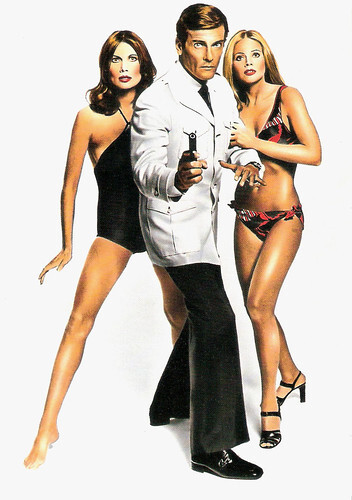
Dutch postcard by Loeb Uitgevers BV, Amsterdam, no. 5992805, 1985. Photo: Eon Productions / Gilrose Publications / Danjaq S.A. Publicity still for The Man with the Golden Gun (Guy Hamilton, 1974).
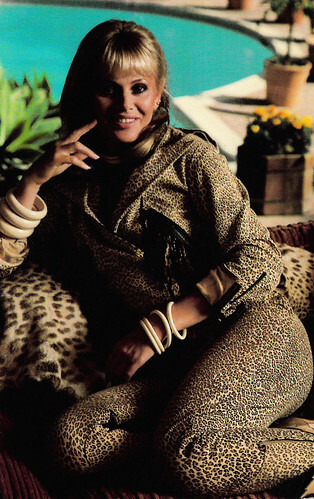
American postcard by Coral-Lee, Rancho Cordova, no. CL/Personality # 78. Photo: Douglas Kirkland, 1981.
Sources: (IMDb), Wikipedia (Swedish, Dutch and English) and .

Dutch postcard by Loeb Uitgevers BV, Amsterdam, 1985. Photo: Eon Productions / Gilrose Publications / Danjaq S.A. Roger Moore , Maud Adams and Britt Ekland in The Man with the Golden Gun (Guy Hamilton, 1974).

Vintage postcard in the Bond Girls series. Britt Ekland in The Man With the Golden Gun (Guy Hamilton, 1974).
The poster girl for beautiful, big-eyed Scandinavian blondes
Britt Ekland was born Britt-Marie Eklund in Stockholm, Sweden, in 1942. Her parents were Eva Maria Birgitta Löwgren, a secretary, and Sven Axel Tankred Eklund, who ran an upmarket clothing store in Stockholm and was captain of the Swedish national curling team, four-time national champion and one-time president of the World Curling Federation. She had a brother, Carl Eklund. Britt grew up to be the poster girl for beautiful, big-eyed Scandinavian blondes. She studied at the Calle Flygare Theatre School. After her studies, she was hired by Povel Ramel to participate in his travelling theatre group Knäppupprevyer. In Italy, she was spotted in a coffee shop by a talent agent who sent her to London to audition for films.
Ekland had small roles in the Swedish films Kort är sommaren / Summer is Short (Bjarne Henning-Jensen, 1962) with Jarl Kulle and Bibi Andersson , and Det är hos mig han har varit / It Is With Me That He Has Been (Arne Mattsson, 1963), before landing her a small part in the Western Advance to the Rear (George Marshall, 1964) starring Glenn Ford . When Peter Sellers met her in a hotel, he fell hard for her and they wed just 10 days after meeting. While on their honeymoon in Hollywood, Peter inhaled amyl nitrites during sex, causing a series of eight heart attacks. Sellers was rushed to the hospital but survived.
Tony Fontana at IMDb : "The combination of Sellers' stardom and her stunning beauty contributed to her fame (the fact that Sellers suffered a heart attack in bed on their wedding night did not hurt, either). " In 1965, the couple had a daughter, Victoria. Once the baby is born, their relationship becomes strained. Sellers and Ekland made three films together. In 1964 they appeared in the American Christmas television film A Carol for Another Christmas (Joseph L. Mankiewicz, 1964). They followed this with the enjoyable Italian farce Caccia alla volpe / After the Fox (Vittorio De Sica, 1966), written by Neil Simon. Their last film together was the British comedy The Bobo (Robert Parrish, 1967). The couple divorced as early as 1968.
Britt Ekland's claim to fame came as the young Amish girl who invented the striptease in the musical comedy The Night They Raided Minsky's (William Friedkin, 1968) with Jason Robards, which established her as a sex symbol. Throughout the 1960s she played major roles in The Double Man (Franklin J. Schaffner, 1967) opposite Yul Brynner , the Italian crime film Gli intoccabili / Machine Gun McCain (Giuliano Montaldo, 1969) with John Cassavetes, and the crime film Stiletto (Bernard L. Kowalski, 1969), based on a novel by Harold Robbins.
Britt Ekland had a son, Nicolai Adler (1973), with record and film producer Lou Adler. She had several other relationships with well-known figures such as pop singer Rod Stewart. They were introduced in 1975 by Joan Collins and lived together for more than two years, with Ekland giving up her career to focus on their relationship. In 1976 Ekland provided the French-spoken part at the end of Stewart's single 'Tonight's the Night (Gonna Be Alright)'. It was 1977's overall #1 song. From 1979 to 1981, she dated and became engaged to singer Phil Lewis of the groups Girl and L.A. Guns. In 1984, at age 42, she married a second time, this time to Slim Jim Phantom, drummer of the Stray Cats, who was 23. They had a son, Thomas Jefferson, in 1988. The couple divorced in 1992.

Vintage postcard.

Vintage postcard.
Mary Goodnight
Britt Ekland appeared opposite Michael Caine in the classic British crime film Get Carter (Mike Hodges, 1971). She also starred in several Horror films, including the cult classic The Wicker Man (Robin Hardy, 1973).
Ekland had already auditioned to play a Bond girl in the first Bond film Dr No (1962), but the role eventually went to Ursula Andress . She finally played Bond girl Mary Goodnight in the James Bond film The Man with the Golden Gun (Guy Hamilton, 1974), starring Roger Moore .
Ekland continued to act throughout the 1970s, with roles in films such as Royal Flash (Richard Lester, 1975) starring Malcolm McDowell , High Velocity (Remi Kramer, 1976) with Ben Gazzara, and King Solomon's Treasure (Alvin Rakoff, 1979).
During the 1980s, she acted in such films as the sex comedy Fraternity Vacation (James Frawley, 1985) and the Slasher movie Moon in Scorpio (Gary Graver, 1988). She played prostitute Mariella Novotny in Scandal (Michael Caton-Jones, 1989) about the Profumo Affair of 1963, an affair between an exotic dancer (Joanne Whalley) and the Minister of War ( Ian Mc Kellen ) that shook up the British government. Since the early 1990s, her acting work has mainly consisted of stage shows, one-off roles, cameos, and appearances on reality television. Her last feature films were The Children (Tony Palmer, 1990) starring Ben Kingsley and Kim Novak and the Swedish drama Sök / Search (Maria von Heland, 2006) starring Amanda Ooms.
Britt Ekland was very much into the fitness trend. She wrote a book on the subject, 'Sensual Beauty: How to Achieve It' (1984), and made a fitness video in 1992. She also wrote the tell-all autobiography 'True Britt' (1981) and the novel 'Det ljuva livet / Sweet Life' (1993/1994). In 2004, Charlize Theron portrayed Ekland in The Life and Death of Peter Sellers (Stephen Hopkins, 2004). Ekland accompanied Theron to the Cannes Film Festival, where she became highly emotional when she saw the film. She is a long-time resident of Los Angeles, USA.

Dutch postcard by Loeb Uitgevers BV, Amsterdam, no. 5992805, 1985. Photo: Eon Productions / Gilrose Publications / Danjaq S.A. Publicity still for The Man with the Golden Gun (Guy Hamilton, 1974).

American postcard by Coral-Lee, Rancho Cordova, no. CL/Personality # 78. Photo: Douglas Kirkland, 1981.
Sources: (IMDb), Wikipedia (Swedish, Dutch and English) and .
Published on April 13, 2025 22:00
April 12, 2025
Atlantis (1913)
The classic Danish silent film Atlantis (1913) was directed by August Blom for Nordisk. The monumental film was based on the 1912 novel by famous German author Gerhart Hauptmann about a doctor who travels to the United States in search of a cure for his ailing wife, but his ocean liner sinks at sea. Nordisk star Olaf Fønss and Hauptmann's girlfriend, Austrian theatre actress Ida Orloff, played the leads.
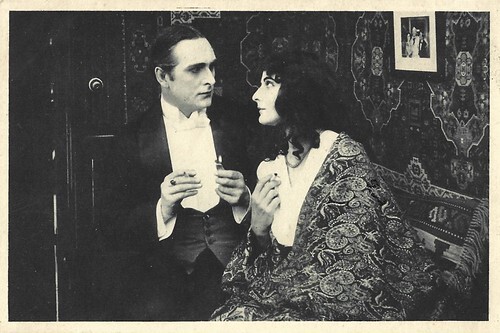
German postcard. Photo: Nordische Film / Nordisk. Olaf Fönss as Dr. Friedrich von Kammacher and probably Alma Hinding as his maddened wife in Atlantis (August Blom, 1913).
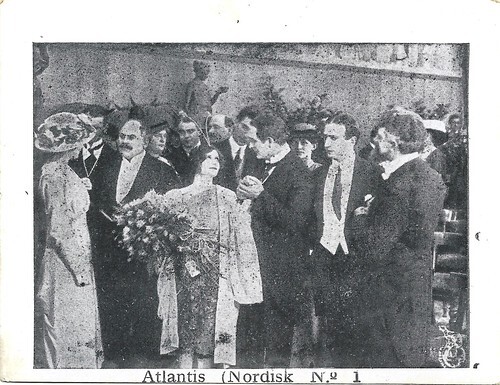
Spanish collector card by Reclam Films, no. 1 of 6. Photo: Nordisk. Olaf Fønss and Ida Orloff as Ingigerd Hahlstrøm in Atlantis (August Blom, 1913).
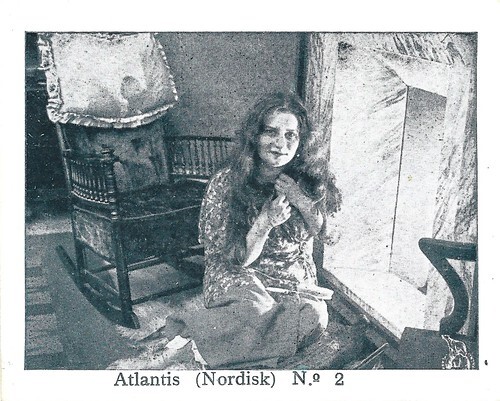
Spanish collector card by Reclam Films, no. 2 of 6. Photo: Nordisk. Ida Orloff in Atlantis (August Blom, 1913).
Only one year after the sinking of the RMS Titanic
Atlantis (1913) is a Danish silent drama directed by August Blom, the head of production at the Nordisk Film Company. As Atlantis had many locations at home and abroad (including the streets of Berlin, but also Dragør, Amager, Klampenborg (Denmark), Finse (Norway) and New York City) and numerous scenes were to be shot simultaneously, Nordisk-Film engaged the Danish director Robert Dinesen and the young Hungarian filmmaker Mihály Kertész - the later Michael Curtiz - as assistant directors. Kertész also made a brief appearance in front of the camera with Kammacher's student friend Hans Füllenberg.
Doctor Friedrich von Kammacher ( Olaf Fönss ) is a well-known bacteriologist. When his wife Angèle becomes mentally ill, he has Angèle admitted to a specialist clinic and follows his parents' advice to travel to Berlin. There he wants to get some distance from the events of the past and recharge his batteries both mentally and physically. In the German capital, Kammacher meets the dancer Ingigerd Hahlstrøm (Ida Orloff) at a matinee. Her seductive dance ‘The Sacrifice of the Spider’ does not fail to have an effect on the doctor. When he reads in a newspaper that Ingigerd will travel to New York on the passenger steamer SS Roland, Von Kammacher also buys a ticket.
The crossing turns out to be a disaster. Kammacher learns that Ingigerd, who is travelling decadently with her pet monkey and a white cockatoo, already has a steady companion on board, although that does not stop her from flirting with him either. Halfway through the journey, there is a serious collision with a shipwreck in the middle of a fog bank. The Roland is badly damaged, the water pours in and the ship begins to sink. Panic ensues among the people.
Ingigerd can no longer get her cabin door open and suffers a fainting fit as a result. Kammacher enters the cabin from outside and carries her into a lifeboat. During the catastrophic wreck of the ship, many drown, including Ingigerd's wealthy father. Once landed, Ingigerd gives up her profession as a dancer, which has always been her vocation, and retakes her frivolous life and rejects Friedrich. He meets a female sculptor, Eva ( Ebba Thomsen ), and they become good friends. A good friend lends Friedrich his lodge in the mountains, so he can recover. Kammacher receives a telegram that his wife Angèle has died. As a result, the widower falls seriously ill. Eva tends to him and they fall in love. With her, he returns to Europe.
The production of Atlantis (August Blom, 1913) was already considered so lavish and enormous during the filming period that even serious newspapers wrote about it at a time when cinematography, which had previously been considered disreputable, was barely reported on. Released only one year after the sinking of the RMS Titanic, Atlantis (1913) drew considerable attention as well as criticism due to similarities to the actual tragedy. However, Hauptmann's novel was published in serialised form in the Berliner Tageblatt a month before the Titanic disaster.
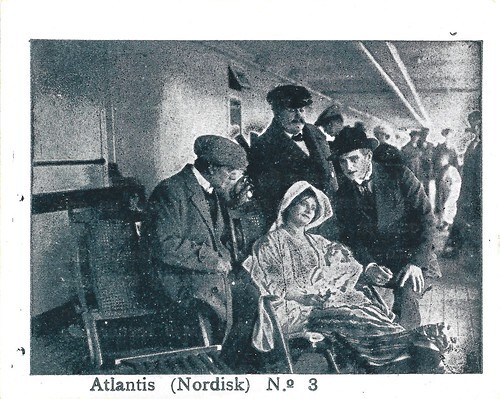
Spanish collector card by Reclam Films, no. 3 of 6. Photo: Nordisk. Olaf Fønss and Ida Orloff in Atlantis (August Blom, 1913).
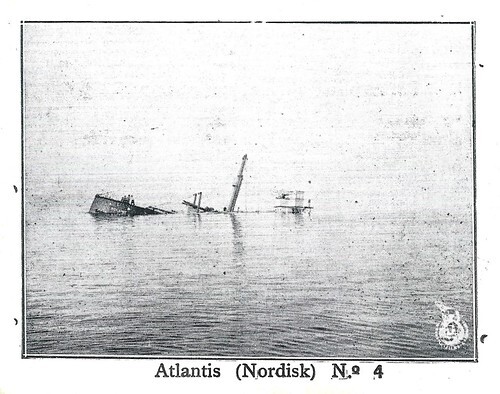
Spanish collector card by Reclam Films, no. 4 of 6. Photo: Nordisk. Scene from Atlantis (August Blom, 1913). The shipwreck of the ocean liner Roland.
An attempt to raise the quality of cinematography
Atlantis (August Blom, 1913) was based on the 1912 novel by Gerhart Hauptmann. It starred an international cast headlined by Danish matinée idol Olaf Fønss and Austrian-Russian opera diva Ida Orloff, Hauptmann's friend. Because his original story was partly autobiographical, Hauptmann's contract with Nordisk Film required two roles to be acted by the actual people who were their inspiration. The parts of Ingigerd and the armless virtuoso Arthur Stoss were played by the same persons, who were Hauptmann's models when he wrote his novel.
These two, Ida Orloff and Carl Herman Unthan were his traveling companions on Hauptmann's trip across the Atlantic. Orloff had had a romantic relationship with Hauptmann beginning several years earlier when she was a 16-year-old cabaret dancer. Reviewers of Atlantis criticised the choice of Orloff because, by the time of filming, she was no longer a svelte athletic dancer who could embody the eroticism of the part. The other required actor was Carl Herman Unthan (credited as Charles Unthan), a Prussian violinist who had been born without arms and learned to use his feet as hands. Although his abilities were impressive, critics of Atlantis felt his appearance in the film was simply extraneous and non-integral to the story. Nevertheless, Nordisk Films had been forced to cast them.
Around 80 leading actors and around 100 supporting actors were engaged in the ship scenes. In addition, an ocean liner (the C. F. Tietgen of the Danish shipping company DFDS), three overseas cargo ships, two tugboats, numerous motorboats and a wreck rebuilt at considerable expense were used. The sinking scene used a large-scale model and about 500 extras as swimmers and was filmed in the bay of Køge, Denmark. With production costs of around half a million kroner - 80,000 kroner for the sinking of the ship - Atlantis was considered the most expensive film of its time and also the first monumental production in Scandinavia. The film's running time of almost two hours was also unusually long for the time.
This film adaptation of Gerhart Hauptmann's literary novel stands for an attempt to raise the quality of cinematography, which until then had been regarded as little more than simple fairground entertainment, with the auteur film and thus to meet a gradually emancipating public taste. In 1913, ambitious literary film adaptations were made in various Central European countries. In Denmark, in addition to Atlantis, an adaptation of Arthur Schnitzler's 'Liebelei' was produced, Elskovsleg (August Blom, Holger-Madsen, 1913). In Germany, the literary films Der Andere/The Other (Max Mack, 1913) with Albert Bassermann and based on a play by Paul Lindau, and the Edgar Alan Poe adaptation Der Student von Prag/The Student of Prague (Hanns Heinz Ewers, Stellan Rye, 1913) starring Paul Wegener , were made. In Austria-Hungary, the theatre star Alexander Girardi played a selection of his greatest theatre successes in his country's first major film production, Der Millionenonkel/The Millionaire's Uncle (Hubert Marischka, 1913).
Atlantis (August Blom, 1913) was not a huge box office hit at the time. The film was worldwide distributed, with an unhappy ending for the Russians. In Germany, the country of Gerhart Hauptmann, the film did exceptionally well, in other countries rather poorly. In Norway, the film was banned because authorities felt it was in poor taste to turn a tragedy into entertainment. Decades later, film historian Erik Ulrichsen hailed the film as a masterpiece of Danish early cinema and one of the first modern films. Atlantis was restored and released on LaserDisc in 1993 and in DVD format in 2005. The restoration was created through a high-definition scan of a restored negative and the tinting was recreated using an abbreviated version from The National Film Center in Japan.
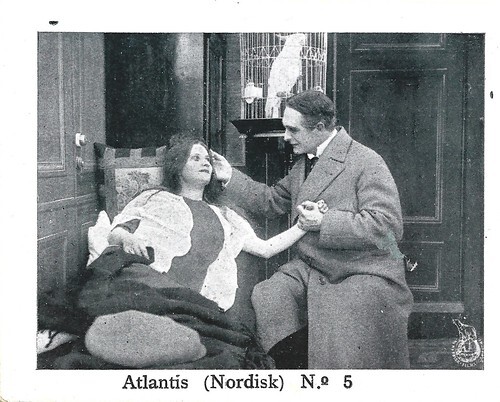
Spanish collector card by Reclam Films, no. 5 of 6. Photo: Nordisk. Olaf Fønss and Ida Orloff in Atlantis (August Blom, 1913).
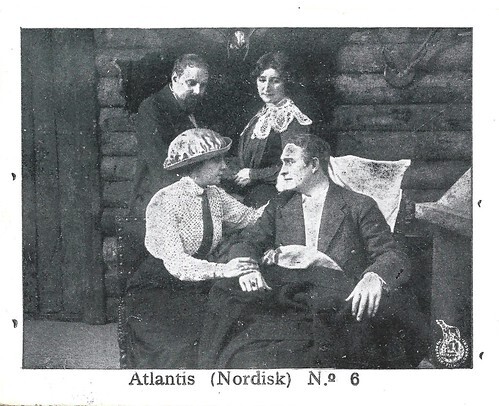
Spanish collector card by Reclam Films, no. 6 of 6. Photo: Nordisk. Olaf Fønss and Ebba Thomsen as Eva in Atlantis (August Blom, 1913).
Sources: Wikipedia (German and English) and IMDb.

German postcard. Photo: Nordische Film / Nordisk. Olaf Fönss as Dr. Friedrich von Kammacher and probably Alma Hinding as his maddened wife in Atlantis (August Blom, 1913).

Spanish collector card by Reclam Films, no. 1 of 6. Photo: Nordisk. Olaf Fønss and Ida Orloff as Ingigerd Hahlstrøm in Atlantis (August Blom, 1913).

Spanish collector card by Reclam Films, no. 2 of 6. Photo: Nordisk. Ida Orloff in Atlantis (August Blom, 1913).
Only one year after the sinking of the RMS Titanic
Atlantis (1913) is a Danish silent drama directed by August Blom, the head of production at the Nordisk Film Company. As Atlantis had many locations at home and abroad (including the streets of Berlin, but also Dragør, Amager, Klampenborg (Denmark), Finse (Norway) and New York City) and numerous scenes were to be shot simultaneously, Nordisk-Film engaged the Danish director Robert Dinesen and the young Hungarian filmmaker Mihály Kertész - the later Michael Curtiz - as assistant directors. Kertész also made a brief appearance in front of the camera with Kammacher's student friend Hans Füllenberg.
Doctor Friedrich von Kammacher ( Olaf Fönss ) is a well-known bacteriologist. When his wife Angèle becomes mentally ill, he has Angèle admitted to a specialist clinic and follows his parents' advice to travel to Berlin. There he wants to get some distance from the events of the past and recharge his batteries both mentally and physically. In the German capital, Kammacher meets the dancer Ingigerd Hahlstrøm (Ida Orloff) at a matinee. Her seductive dance ‘The Sacrifice of the Spider’ does not fail to have an effect on the doctor. When he reads in a newspaper that Ingigerd will travel to New York on the passenger steamer SS Roland, Von Kammacher also buys a ticket.
The crossing turns out to be a disaster. Kammacher learns that Ingigerd, who is travelling decadently with her pet monkey and a white cockatoo, already has a steady companion on board, although that does not stop her from flirting with him either. Halfway through the journey, there is a serious collision with a shipwreck in the middle of a fog bank. The Roland is badly damaged, the water pours in and the ship begins to sink. Panic ensues among the people.
Ingigerd can no longer get her cabin door open and suffers a fainting fit as a result. Kammacher enters the cabin from outside and carries her into a lifeboat. During the catastrophic wreck of the ship, many drown, including Ingigerd's wealthy father. Once landed, Ingigerd gives up her profession as a dancer, which has always been her vocation, and retakes her frivolous life and rejects Friedrich. He meets a female sculptor, Eva ( Ebba Thomsen ), and they become good friends. A good friend lends Friedrich his lodge in the mountains, so he can recover. Kammacher receives a telegram that his wife Angèle has died. As a result, the widower falls seriously ill. Eva tends to him and they fall in love. With her, he returns to Europe.
The production of Atlantis (August Blom, 1913) was already considered so lavish and enormous during the filming period that even serious newspapers wrote about it at a time when cinematography, which had previously been considered disreputable, was barely reported on. Released only one year after the sinking of the RMS Titanic, Atlantis (1913) drew considerable attention as well as criticism due to similarities to the actual tragedy. However, Hauptmann's novel was published in serialised form in the Berliner Tageblatt a month before the Titanic disaster.

Spanish collector card by Reclam Films, no. 3 of 6. Photo: Nordisk. Olaf Fønss and Ida Orloff in Atlantis (August Blom, 1913).

Spanish collector card by Reclam Films, no. 4 of 6. Photo: Nordisk. Scene from Atlantis (August Blom, 1913). The shipwreck of the ocean liner Roland.
An attempt to raise the quality of cinematography
Atlantis (August Blom, 1913) was based on the 1912 novel by Gerhart Hauptmann. It starred an international cast headlined by Danish matinée idol Olaf Fønss and Austrian-Russian opera diva Ida Orloff, Hauptmann's friend. Because his original story was partly autobiographical, Hauptmann's contract with Nordisk Film required two roles to be acted by the actual people who were their inspiration. The parts of Ingigerd and the armless virtuoso Arthur Stoss were played by the same persons, who were Hauptmann's models when he wrote his novel.
These two, Ida Orloff and Carl Herman Unthan were his traveling companions on Hauptmann's trip across the Atlantic. Orloff had had a romantic relationship with Hauptmann beginning several years earlier when she was a 16-year-old cabaret dancer. Reviewers of Atlantis criticised the choice of Orloff because, by the time of filming, she was no longer a svelte athletic dancer who could embody the eroticism of the part. The other required actor was Carl Herman Unthan (credited as Charles Unthan), a Prussian violinist who had been born without arms and learned to use his feet as hands. Although his abilities were impressive, critics of Atlantis felt his appearance in the film was simply extraneous and non-integral to the story. Nevertheless, Nordisk Films had been forced to cast them.
Around 80 leading actors and around 100 supporting actors were engaged in the ship scenes. In addition, an ocean liner (the C. F. Tietgen of the Danish shipping company DFDS), three overseas cargo ships, two tugboats, numerous motorboats and a wreck rebuilt at considerable expense were used. The sinking scene used a large-scale model and about 500 extras as swimmers and was filmed in the bay of Køge, Denmark. With production costs of around half a million kroner - 80,000 kroner for the sinking of the ship - Atlantis was considered the most expensive film of its time and also the first monumental production in Scandinavia. The film's running time of almost two hours was also unusually long for the time.
This film adaptation of Gerhart Hauptmann's literary novel stands for an attempt to raise the quality of cinematography, which until then had been regarded as little more than simple fairground entertainment, with the auteur film and thus to meet a gradually emancipating public taste. In 1913, ambitious literary film adaptations were made in various Central European countries. In Denmark, in addition to Atlantis, an adaptation of Arthur Schnitzler's 'Liebelei' was produced, Elskovsleg (August Blom, Holger-Madsen, 1913). In Germany, the literary films Der Andere/The Other (Max Mack, 1913) with Albert Bassermann and based on a play by Paul Lindau, and the Edgar Alan Poe adaptation Der Student von Prag/The Student of Prague (Hanns Heinz Ewers, Stellan Rye, 1913) starring Paul Wegener , were made. In Austria-Hungary, the theatre star Alexander Girardi played a selection of his greatest theatre successes in his country's first major film production, Der Millionenonkel/The Millionaire's Uncle (Hubert Marischka, 1913).
Atlantis (August Blom, 1913) was not a huge box office hit at the time. The film was worldwide distributed, with an unhappy ending for the Russians. In Germany, the country of Gerhart Hauptmann, the film did exceptionally well, in other countries rather poorly. In Norway, the film was banned because authorities felt it was in poor taste to turn a tragedy into entertainment. Decades later, film historian Erik Ulrichsen hailed the film as a masterpiece of Danish early cinema and one of the first modern films. Atlantis was restored and released on LaserDisc in 1993 and in DVD format in 2005. The restoration was created through a high-definition scan of a restored negative and the tinting was recreated using an abbreviated version from The National Film Center in Japan.

Spanish collector card by Reclam Films, no. 5 of 6. Photo: Nordisk. Olaf Fønss and Ida Orloff in Atlantis (August Blom, 1913).

Spanish collector card by Reclam Films, no. 6 of 6. Photo: Nordisk. Olaf Fønss and Ebba Thomsen as Eva in Atlantis (August Blom, 1913).
Sources: Wikipedia (German and English) and IMDb.
Published on April 12, 2025 22:00
April 11, 2025
Marcel Dalio
French actor Marcel Dalio (1900-1983) or simply Dalio was a citizen of the world. During the 1930s, he became a much sought-after character actor in France. His lovely animated face with its great expressive eyes became familiar across Europe when he appeared in Jean Renoir's masterpieces La règle du jeu / The Rules of the Game (1939) and La Grande Illusion / Grand Illusion (1937). During the war, he worked in Hollywood and appeared in such classics as Casablanca (1942) and To Have and Have Not (1944).
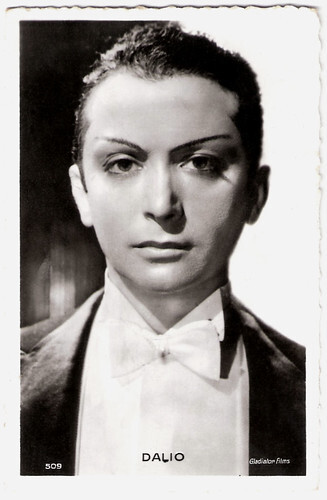
French postcard by Ed. Chantal, Paris, no. 509. Photo: Gladiator Films.
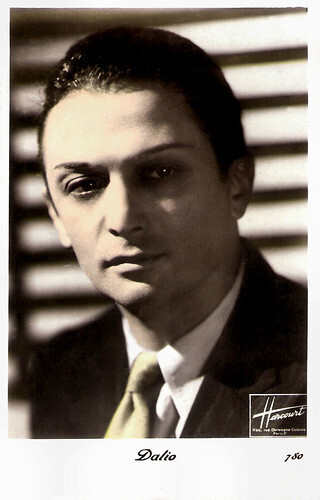
French postcard, no. 780. Photo: Studio Harcourt.
Short of stature but a giant in talent
Marcel Dalio was born Israel Moshe Blauschild in Paris, France in 1900. His parents were Romanian-Jewish immigrants. After a stint at the National Drama Conservatoire (CNSAD), he performed in cabarets, revues and stage plays during the 1920s.
From 1931 on, he acted in popular French films like Pépé le Moko (Julien Duvivier, 1937) starring Jean Gabin as an infamous gangster, who tries to escape the police by hiding in the casbah of the city of Algiers. Dalio also appeared in Jean Renoir 's masterpieces La Grande Illusion / Grand Illusion (1937) and La règle du jeu / The Rules of the Game (1939) about upper-class French society just before the start of World War II. These films made his expressive face famous. “Short of stature but a giant in talent”, wrote Hal Erickson at AllMovie about him.
After divorcing his first wife, actress Jany Holt , he married the seventeen-year-old and breathtakingly beautiful actress Madeleine Lebeau in 1939. Michael Ryerson at IMDb : “Marcel Dalio had it all, but then the Germans crushed Poland, swept across Belgium and pressed on toward Paris. He waited until the last possible moment and finally, with the sound of artillery audible, with Madeleine, fled in a borrowed car to Orleans and then, in a freight train, to Bordeaux and finally to Portugal. In Lisbon, they bribed a crooked immigration official and were surreptitiously given two visas for Chile.”
However, when their ship, the S.S. Quanza, stopped in Mexico, they were stranded (along with around 200 other passengers) when the Chilean visas they had purchased turned out to be forgeries. Eventually, they were able to get temporary Canadian passports. In occupied France, the Germans used publicity stills of Dalio for a series of posters labelled 'the typical Jew'. Dalio's parents would die in Nazi concentration camps during the war.
The Nazis ordered the film Entrée des artistes / Stage Door (Marc Allégret, 1938) to be re-edited. All of Dalio's scenes were deleted and re-shot with the Aryan actor (Fred Pasquali). James Travers at French Films “Marcel Dalio almost steals the final act as an investigating magistrate - it is incredible to think that his scenes were re-shot with another actor.” Fortunately, the scenes with Dalio were reinstated after the war.
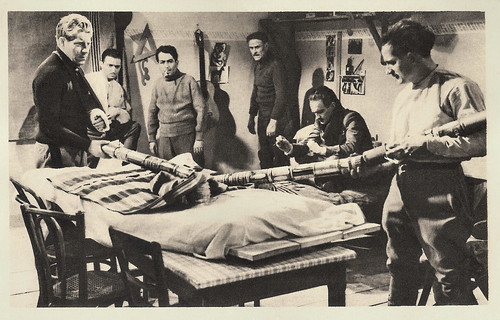
French postcard by Crépa, Editeur, Paris. Photo: Sam Lévin. Jean Gabin , Dalio, Carette , Gaston Modot and Pierre Fresnay in La grande illusion/The Grand Illusion (Jean Renoir, 1937).
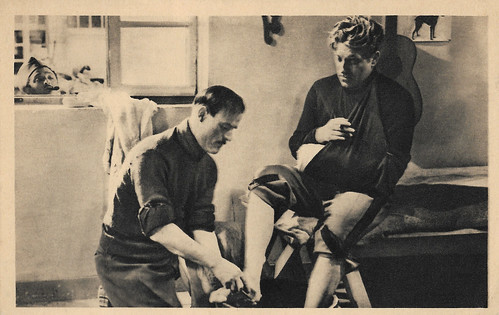
French postcard by Crépa, Editeur, Paris. Photo: Sam Lévin / Production R.A.C. Marcel Dalio, Gaston Modot and Jean Gabin in La grande illusion/The Grand Illusion (Jean Renoir, 1937).
Everybody comes to Rick's
Friends in the film industry arranged for Marcel Dalio and Madeleine Lebeau to arrive in Hollywood. Nearly broke, Dalio played in a string of largely forgettable films. Interesting was the Film Noir The Shanghai Gesture (Josef von Sternberg, 1941) starring Gene Tierney .
In early 1942, Jack L. Warner was driving the production of a film based on a one-act play, 'Everybody Comes to Rick's' but he had no screenplay. Shooting started with a mishmash of treatments loosely based on the play and two previous movies. Dalio and Madeleine Lebeau were cast as, respectively, a croupier and a romantic entanglement for the male lead.
The film starred Humphrey Bogart , Ingrid Bergman , and Paul Henreid, and features Claude Rains , Conrad Veidt , and Peter Lorre . The final result is the classic Casablanca (Michael Curtiz, 1942).
Michael Ryerson at IMDb : “And when Claude Rains delivers the signature line, 'I'm shocked! Shocked! To find that there's gambling going on in here!' the croupier, Emil, played by Marcel Dalio, approaches from the roulette table and says simply, 'Your winnings, sir.' It is a delicious moment ripe with scripted irony, one among many in this film, but one made all the more so, knowing where Dalio came from and what he and his wife had endured to arrive at that line.”
However, Dalio was unbilled for this memorable part. In 1943, he received some larger roles, like a French policeman in The Song of Bernadette (Henry King, 1943). In Hollywood, Marcel Dalio was never able to rescale the heights of prominence that he had enjoyed in France and was too often cast as the stereotypical Frenchman. One of his best-known roles was in the film adaptation of the romantic war adventure To Have and Have Not (Howard Hawks, 1944), opposite Humphrey Bogart. Dalio appeared in 19 Hollywood movies during the Second World War.
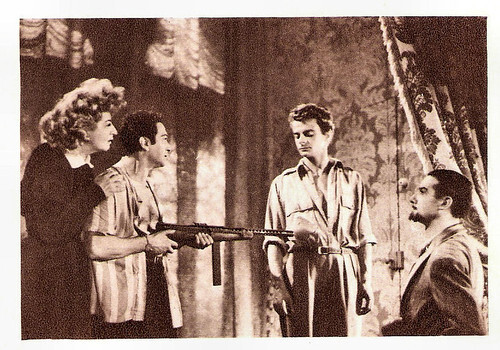
French collectors card. Photo: publicity still for Les amants de Vérone / The Lovers of Verona (André Cayatte, 1949) with Serge Reggiani , and left Marianne Oswald and Marcel Dalio and right, Pierre Brasseur , right.
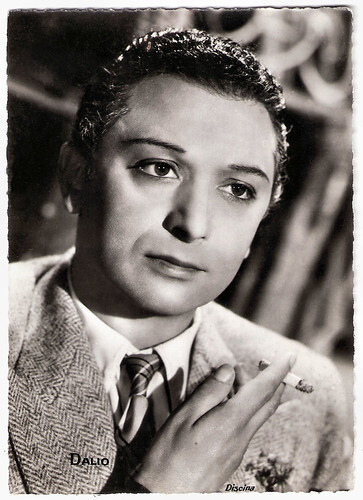
French postcard by Collection Chantal, Paris, no. 469. Photo: Discina.
Gentlemen prefer blondes
When the Second World War ended in May 1945, Marcel Dalio returned to France to continue his film career. His first appearance that year was in Son dernier role / Her Last Part (Jean Gourguet, 1946) with Gaby Morlay . He appeared in ten more films in France and one in England through the late 1940s. He played Captain Nikarescu in Black Jack (Julien Duvivier, José Antonio Nieves Conde, 1950).
In 1953, Dalio appeared in Gentlemen Prefer Blondes (Howard Hawks, 1953) starring Jane Russell and Marilyn Monroe , and Flight to Tangier (Charles Marquis Warren, 1953) starring Joan Fontaine . In 1954, Dalio appeared in two American movies before returning to France, Lucky Me (Jack Donohue, 1954) starring Doris Day and Sabrina (Billy Wilder, 1954) starring Bogart and Audrey Hepburn . In the romantic comedy Sabrina, the bearded Dalio played one of Hepburn's fellow cooking students in Paris.
He also reunited with Jean Gabin in the French gangster film Razzia sur la chnouf / Raid on the Drug Ring (Henri Decoin, 1955) based on a novel by Auguste Le Breton. That year, he went back to America to appear in the poorly-received television series Casablanca (1955-1956), where he portrayed the Claude Rains character, Captain Renault. Dalio had the role of a French sergeant in the war drama Jump into Hell (David Butler, 1955) about the French defeat at the Battle of Dien Bien Phu in Vietnam. He went on to appear in several Hollywood productions, including the hit comedy Pillow Talk (Michael Gordon, 1959) starring Rock Hudson and Doris Day .
He also made films in France, such as the adventure Cartouche (Philippe de Broca, 1962) starring Jean-Paul Belmondo and Claudia Cardinale . Dalio played a small role in the Hollywood mystery The List of Adrian Messenger (John Huston, 1963). This was followed by the part of Father Cluzeot in Donovan's Reef (John Ford, 1963) starring John Wayne . In 1964, Dalio returned to France but he continued to appear in Hollywood productions like How to Steal a Million (William Wyler, 1966) starring Audrey Hepburn . Michael Ryerson at IMDb : “Late in his career, when Mike Nichols was looking for a vaguely familiar face to deliver a long and worldly, near-monologue in Catch-22 (Mike Nichols, 1970), he turned to Dalio. Faced with a hopelessly idealistic young American pilot, Dalio in a tight close-up, delivers a discourse on practical people faced with impractical circumstances, of the virtues of expedience in the face of amorality.”
After this, Marcel Dalio worked almost entirely in France. The best-known of these films is the hilarious comedy Les aventures de Rabbi Jacob / The Mad Adventures of Rabbi Jacob (Gérard Oury, 1973) with Louis de Funès . His last appearance was in a TV movie portraying Lord Exeter in Les Longuelune / The Longuelune (Jean-Daniel Verhaeghe, 1982). After appearing in almost 150 films, Marcel Dalio died in 1983 in his home in Paris. He was married four times: to Jany Holt (1936-1939), to Madeleine Lebeau (1939-1942) and to Michèle Béryl with whom he had a child. Finally, in 1981 he married French journalist Madeleine Prime in Los Angeles.
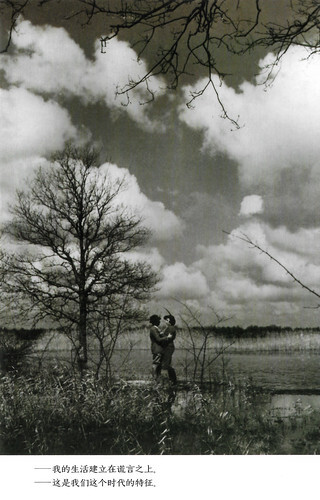
Chinese postcard. Marcel Dalio and Mila Parély in La règle du jeu / Rules of the Game (Jean Renoir, 1939).
Sources: Hal Erickson (AllMovie - Page now defunct), James Travers (French Films), (IMDb), Wikipedia (English and French), and .

French postcard by Ed. Chantal, Paris, no. 509. Photo: Gladiator Films.

French postcard, no. 780. Photo: Studio Harcourt.
Short of stature but a giant in talent
Marcel Dalio was born Israel Moshe Blauschild in Paris, France in 1900. His parents were Romanian-Jewish immigrants. After a stint at the National Drama Conservatoire (CNSAD), he performed in cabarets, revues and stage plays during the 1920s.
From 1931 on, he acted in popular French films like Pépé le Moko (Julien Duvivier, 1937) starring Jean Gabin as an infamous gangster, who tries to escape the police by hiding in the casbah of the city of Algiers. Dalio also appeared in Jean Renoir 's masterpieces La Grande Illusion / Grand Illusion (1937) and La règle du jeu / The Rules of the Game (1939) about upper-class French society just before the start of World War II. These films made his expressive face famous. “Short of stature but a giant in talent”, wrote Hal Erickson at AllMovie about him.
After divorcing his first wife, actress Jany Holt , he married the seventeen-year-old and breathtakingly beautiful actress Madeleine Lebeau in 1939. Michael Ryerson at IMDb : “Marcel Dalio had it all, but then the Germans crushed Poland, swept across Belgium and pressed on toward Paris. He waited until the last possible moment and finally, with the sound of artillery audible, with Madeleine, fled in a borrowed car to Orleans and then, in a freight train, to Bordeaux and finally to Portugal. In Lisbon, they bribed a crooked immigration official and were surreptitiously given two visas for Chile.”
However, when their ship, the S.S. Quanza, stopped in Mexico, they were stranded (along with around 200 other passengers) when the Chilean visas they had purchased turned out to be forgeries. Eventually, they were able to get temporary Canadian passports. In occupied France, the Germans used publicity stills of Dalio for a series of posters labelled 'the typical Jew'. Dalio's parents would die in Nazi concentration camps during the war.
The Nazis ordered the film Entrée des artistes / Stage Door (Marc Allégret, 1938) to be re-edited. All of Dalio's scenes were deleted and re-shot with the Aryan actor (Fred Pasquali). James Travers at French Films “Marcel Dalio almost steals the final act as an investigating magistrate - it is incredible to think that his scenes were re-shot with another actor.” Fortunately, the scenes with Dalio were reinstated after the war.

French postcard by Crépa, Editeur, Paris. Photo: Sam Lévin. Jean Gabin , Dalio, Carette , Gaston Modot and Pierre Fresnay in La grande illusion/The Grand Illusion (Jean Renoir, 1937).

French postcard by Crépa, Editeur, Paris. Photo: Sam Lévin / Production R.A.C. Marcel Dalio, Gaston Modot and Jean Gabin in La grande illusion/The Grand Illusion (Jean Renoir, 1937).
Everybody comes to Rick's
Friends in the film industry arranged for Marcel Dalio and Madeleine Lebeau to arrive in Hollywood. Nearly broke, Dalio played in a string of largely forgettable films. Interesting was the Film Noir The Shanghai Gesture (Josef von Sternberg, 1941) starring Gene Tierney .
In early 1942, Jack L. Warner was driving the production of a film based on a one-act play, 'Everybody Comes to Rick's' but he had no screenplay. Shooting started with a mishmash of treatments loosely based on the play and two previous movies. Dalio and Madeleine Lebeau were cast as, respectively, a croupier and a romantic entanglement for the male lead.
The film starred Humphrey Bogart , Ingrid Bergman , and Paul Henreid, and features Claude Rains , Conrad Veidt , and Peter Lorre . The final result is the classic Casablanca (Michael Curtiz, 1942).
Michael Ryerson at IMDb : “And when Claude Rains delivers the signature line, 'I'm shocked! Shocked! To find that there's gambling going on in here!' the croupier, Emil, played by Marcel Dalio, approaches from the roulette table and says simply, 'Your winnings, sir.' It is a delicious moment ripe with scripted irony, one among many in this film, but one made all the more so, knowing where Dalio came from and what he and his wife had endured to arrive at that line.”
However, Dalio was unbilled for this memorable part. In 1943, he received some larger roles, like a French policeman in The Song of Bernadette (Henry King, 1943). In Hollywood, Marcel Dalio was never able to rescale the heights of prominence that he had enjoyed in France and was too often cast as the stereotypical Frenchman. One of his best-known roles was in the film adaptation of the romantic war adventure To Have and Have Not (Howard Hawks, 1944), opposite Humphrey Bogart. Dalio appeared in 19 Hollywood movies during the Second World War.

French collectors card. Photo: publicity still for Les amants de Vérone / The Lovers of Verona (André Cayatte, 1949) with Serge Reggiani , and left Marianne Oswald and Marcel Dalio and right, Pierre Brasseur , right.

French postcard by Collection Chantal, Paris, no. 469. Photo: Discina.
Gentlemen prefer blondes
When the Second World War ended in May 1945, Marcel Dalio returned to France to continue his film career. His first appearance that year was in Son dernier role / Her Last Part (Jean Gourguet, 1946) with Gaby Morlay . He appeared in ten more films in France and one in England through the late 1940s. He played Captain Nikarescu in Black Jack (Julien Duvivier, José Antonio Nieves Conde, 1950).
In 1953, Dalio appeared in Gentlemen Prefer Blondes (Howard Hawks, 1953) starring Jane Russell and Marilyn Monroe , and Flight to Tangier (Charles Marquis Warren, 1953) starring Joan Fontaine . In 1954, Dalio appeared in two American movies before returning to France, Lucky Me (Jack Donohue, 1954) starring Doris Day and Sabrina (Billy Wilder, 1954) starring Bogart and Audrey Hepburn . In the romantic comedy Sabrina, the bearded Dalio played one of Hepburn's fellow cooking students in Paris.
He also reunited with Jean Gabin in the French gangster film Razzia sur la chnouf / Raid on the Drug Ring (Henri Decoin, 1955) based on a novel by Auguste Le Breton. That year, he went back to America to appear in the poorly-received television series Casablanca (1955-1956), where he portrayed the Claude Rains character, Captain Renault. Dalio had the role of a French sergeant in the war drama Jump into Hell (David Butler, 1955) about the French defeat at the Battle of Dien Bien Phu in Vietnam. He went on to appear in several Hollywood productions, including the hit comedy Pillow Talk (Michael Gordon, 1959) starring Rock Hudson and Doris Day .
He also made films in France, such as the adventure Cartouche (Philippe de Broca, 1962) starring Jean-Paul Belmondo and Claudia Cardinale . Dalio played a small role in the Hollywood mystery The List of Adrian Messenger (John Huston, 1963). This was followed by the part of Father Cluzeot in Donovan's Reef (John Ford, 1963) starring John Wayne . In 1964, Dalio returned to France but he continued to appear in Hollywood productions like How to Steal a Million (William Wyler, 1966) starring Audrey Hepburn . Michael Ryerson at IMDb : “Late in his career, when Mike Nichols was looking for a vaguely familiar face to deliver a long and worldly, near-monologue in Catch-22 (Mike Nichols, 1970), he turned to Dalio. Faced with a hopelessly idealistic young American pilot, Dalio in a tight close-up, delivers a discourse on practical people faced with impractical circumstances, of the virtues of expedience in the face of amorality.”
After this, Marcel Dalio worked almost entirely in France. The best-known of these films is the hilarious comedy Les aventures de Rabbi Jacob / The Mad Adventures of Rabbi Jacob (Gérard Oury, 1973) with Louis de Funès . His last appearance was in a TV movie portraying Lord Exeter in Les Longuelune / The Longuelune (Jean-Daniel Verhaeghe, 1982). After appearing in almost 150 films, Marcel Dalio died in 1983 in his home in Paris. He was married four times: to Jany Holt (1936-1939), to Madeleine Lebeau (1939-1942) and to Michèle Béryl with whom he had a child. Finally, in 1981 he married French journalist Madeleine Prime in Los Angeles.

Chinese postcard. Marcel Dalio and Mila Parély in La règle du jeu / Rules of the Game (Jean Renoir, 1939).
Sources: Hal Erickson (AllMovie - Page now defunct), James Travers (French Films), (IMDb), Wikipedia (English and French), and .
Published on April 11, 2025 22:00
Paul van Yperen's Blog
- Paul van Yperen's profile
- 13 followers
Paul van Yperen isn't a Goodreads Author
(yet),
but they
do have a blog,
so here are some recent posts imported from
their feed.



